Importance of Stakeholders in Strategic Management
VerifiedAdded on 2023/01/19
|22
|6004
|1
AI Summary
This article discusses the importance of stakeholders in strategic management and how their expectations impact business success. It focuses on Green Cross Heath Limited, a leading pharmacy service provider in New Zealand, and explores the expectations of internal and external stakeholders such as employees, customers, shareholders, and the government. The article also highlights the role of environmental sustainability, business ethics, leadership, global environment, culture, and workplace environment in meeting stakeholder expectations.
Contribute Materials
Your contribution can guide someone’s learning journey. Share your
documents today.
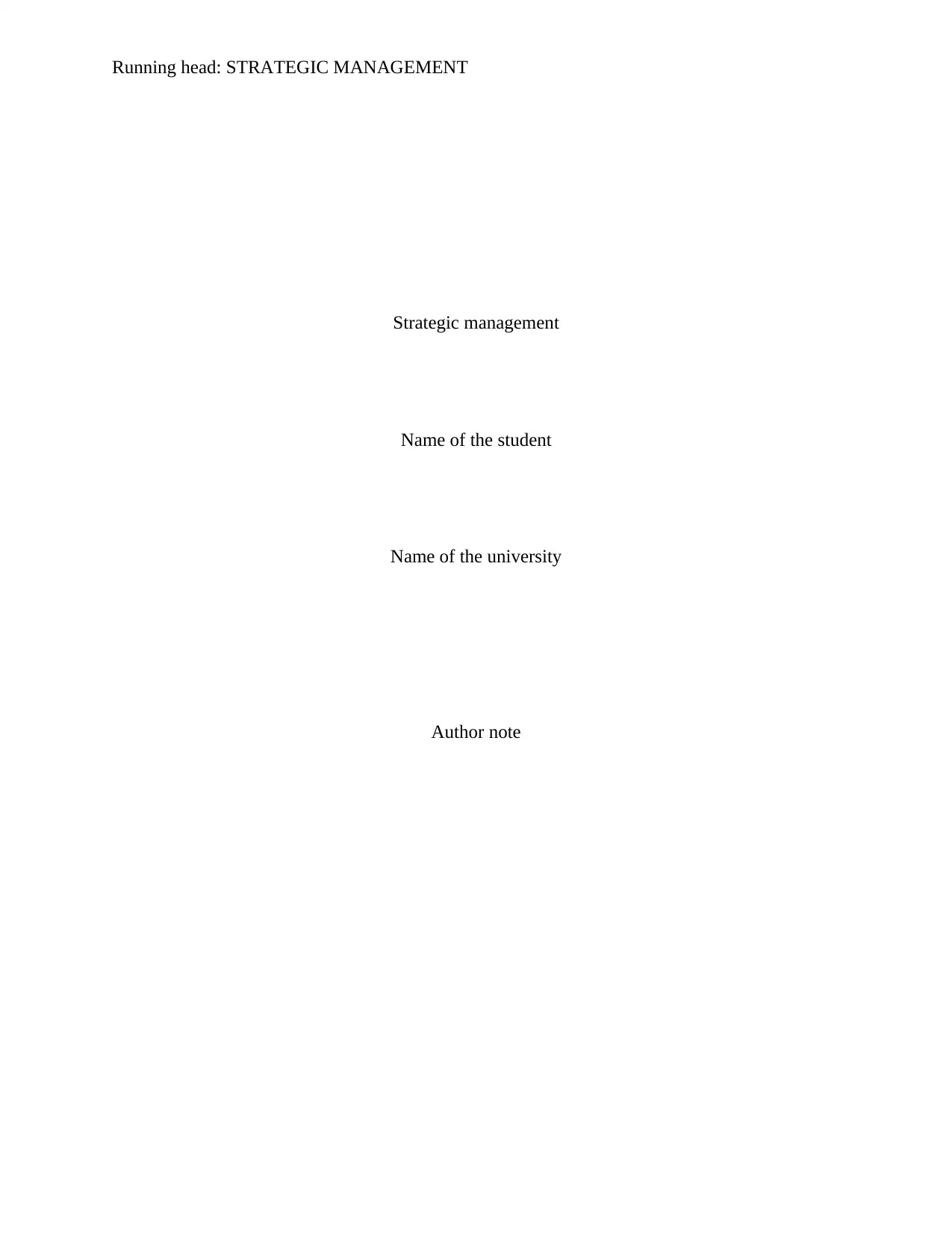
Running head: STRATEGIC MANAGEMENT
Strategic management
Name of the student
Name of the university
Author note
Strategic management
Name of the student
Name of the university
Author note
Secure Best Marks with AI Grader
Need help grading? Try our AI Grader for instant feedback on your assignments.
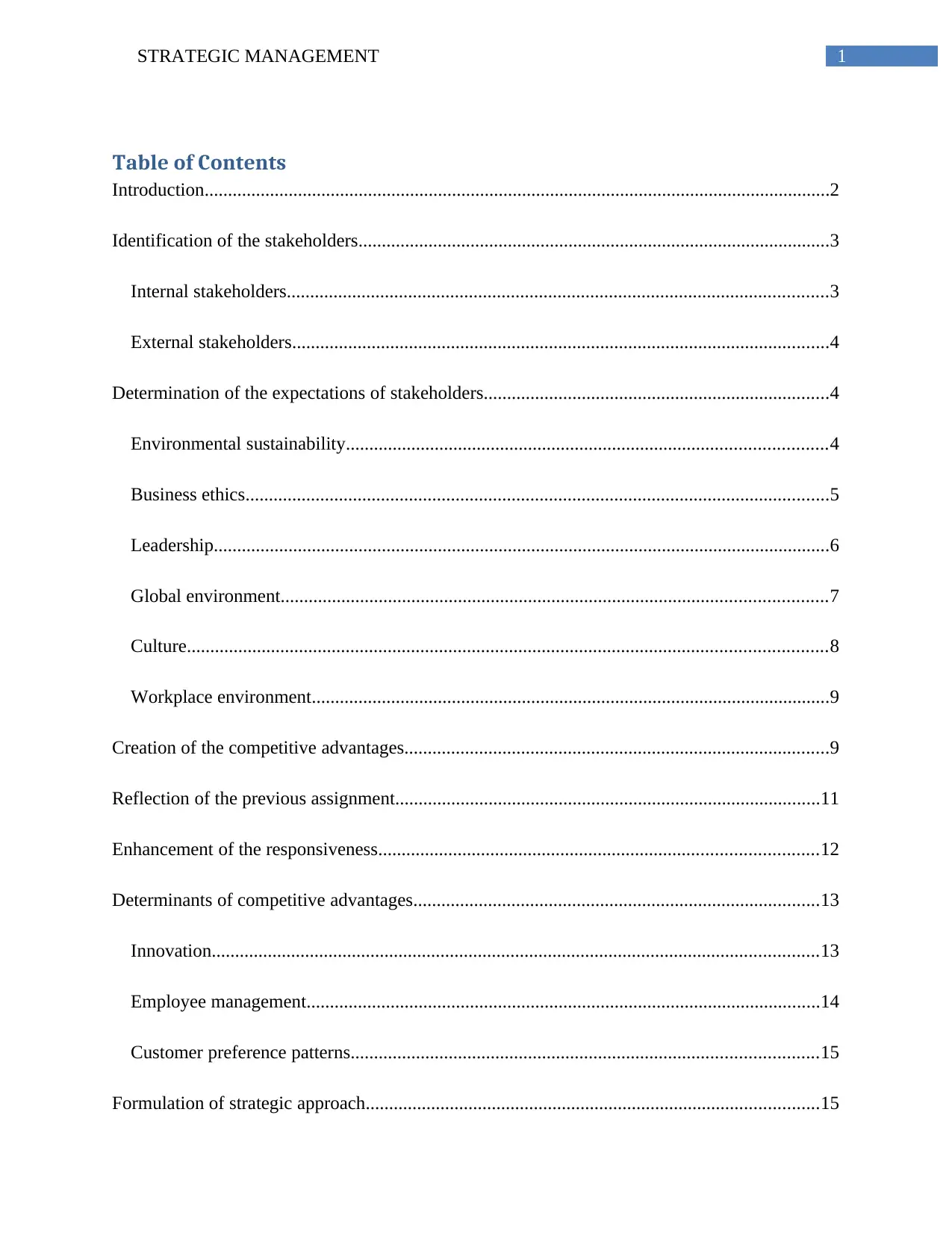
1STRATEGIC MANAGEMENT
Table of Contents
Introduction......................................................................................................................................2
Identification of the stakeholders.....................................................................................................3
Internal stakeholders....................................................................................................................3
External stakeholders...................................................................................................................4
Determination of the expectations of stakeholders..........................................................................4
Environmental sustainability.......................................................................................................4
Business ethics.............................................................................................................................5
Leadership....................................................................................................................................6
Global environment.....................................................................................................................7
Culture.........................................................................................................................................8
Workplace environment...............................................................................................................9
Creation of the competitive advantages...........................................................................................9
Reflection of the previous assignment...........................................................................................11
Enhancement of the responsiveness..............................................................................................12
Determinants of competitive advantages.......................................................................................13
Innovation..................................................................................................................................13
Employee management..............................................................................................................14
Customer preference patterns....................................................................................................15
Formulation of strategic approach.................................................................................................15
Table of Contents
Introduction......................................................................................................................................2
Identification of the stakeholders.....................................................................................................3
Internal stakeholders....................................................................................................................3
External stakeholders...................................................................................................................4
Determination of the expectations of stakeholders..........................................................................4
Environmental sustainability.......................................................................................................4
Business ethics.............................................................................................................................5
Leadership....................................................................................................................................6
Global environment.....................................................................................................................7
Culture.........................................................................................................................................8
Workplace environment...............................................................................................................9
Creation of the competitive advantages...........................................................................................9
Reflection of the previous assignment...........................................................................................11
Enhancement of the responsiveness..............................................................................................12
Determinants of competitive advantages.......................................................................................13
Innovation..................................................................................................................................13
Employee management..............................................................................................................14
Customer preference patterns....................................................................................................15
Formulation of strategic approach.................................................................................................15
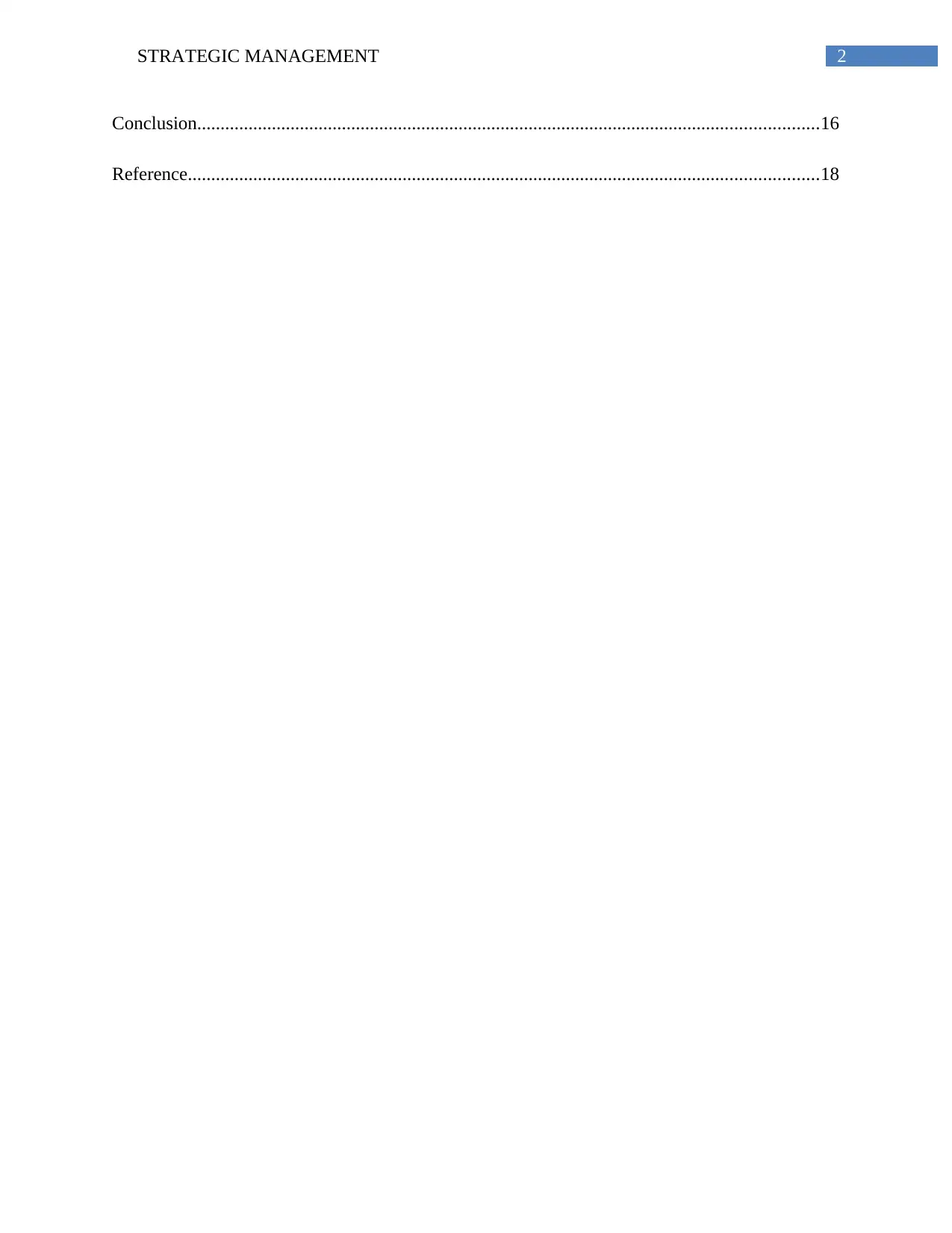
2STRATEGIC MANAGEMENT
Conclusion.....................................................................................................................................16
Reference.......................................................................................................................................18
Conclusion.....................................................................................................................................16
Reference.......................................................................................................................................18
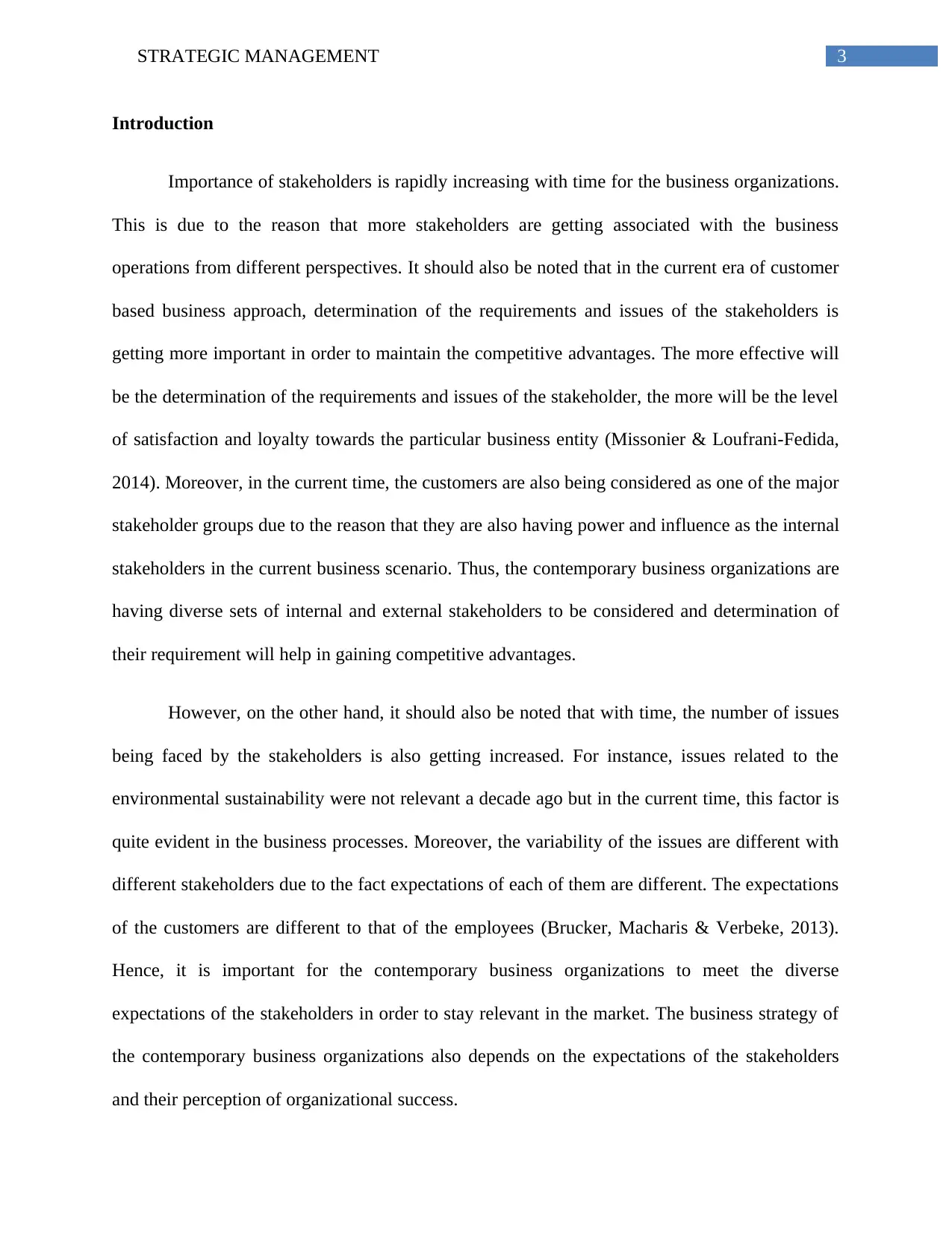
3STRATEGIC MANAGEMENT
Introduction
Importance of stakeholders is rapidly increasing with time for the business organizations.
This is due to the reason that more stakeholders are getting associated with the business
operations from different perspectives. It should also be noted that in the current era of customer
based business approach, determination of the requirements and issues of the stakeholders is
getting more important in order to maintain the competitive advantages. The more effective will
be the determination of the requirements and issues of the stakeholder, the more will be the level
of satisfaction and loyalty towards the particular business entity (Missonier & Loufrani-Fedida,
2014). Moreover, in the current time, the customers are also being considered as one of the major
stakeholder groups due to the reason that they are also having power and influence as the internal
stakeholders in the current business scenario. Thus, the contemporary business organizations are
having diverse sets of internal and external stakeholders to be considered and determination of
their requirement will help in gaining competitive advantages.
However, on the other hand, it should also be noted that with time, the number of issues
being faced by the stakeholders is also getting increased. For instance, issues related to the
environmental sustainability were not relevant a decade ago but in the current time, this factor is
quite evident in the business processes. Moreover, the variability of the issues are different with
different stakeholders due to the fact expectations of each of them are different. The expectations
of the customers are different to that of the employees (Brucker, Macharis & Verbeke, 2013).
Hence, it is important for the contemporary business organizations to meet the diverse
expectations of the stakeholders in order to stay relevant in the market. The business strategy of
the contemporary business organizations also depends on the expectations of the stakeholders
and their perception of organizational success.
Introduction
Importance of stakeholders is rapidly increasing with time for the business organizations.
This is due to the reason that more stakeholders are getting associated with the business
operations from different perspectives. It should also be noted that in the current era of customer
based business approach, determination of the requirements and issues of the stakeholders is
getting more important in order to maintain the competitive advantages. The more effective will
be the determination of the requirements and issues of the stakeholder, the more will be the level
of satisfaction and loyalty towards the particular business entity (Missonier & Loufrani-Fedida,
2014). Moreover, in the current time, the customers are also being considered as one of the major
stakeholder groups due to the reason that they are also having power and influence as the internal
stakeholders in the current business scenario. Thus, the contemporary business organizations are
having diverse sets of internal and external stakeholders to be considered and determination of
their requirement will help in gaining competitive advantages.
However, on the other hand, it should also be noted that with time, the number of issues
being faced by the stakeholders is also getting increased. For instance, issues related to the
environmental sustainability were not relevant a decade ago but in the current time, this factor is
quite evident in the business processes. Moreover, the variability of the issues are different with
different stakeholders due to the fact expectations of each of them are different. The expectations
of the customers are different to that of the employees (Brucker, Macharis & Verbeke, 2013).
Hence, it is important for the contemporary business organizations to meet the diverse
expectations of the stakeholders in order to stay relevant in the market. The business strategy of
the contemporary business organizations also depends on the expectations of the stakeholders
and their perception of organizational success.
Secure Best Marks with AI Grader
Need help grading? Try our AI Grader for instant feedback on your assignments.
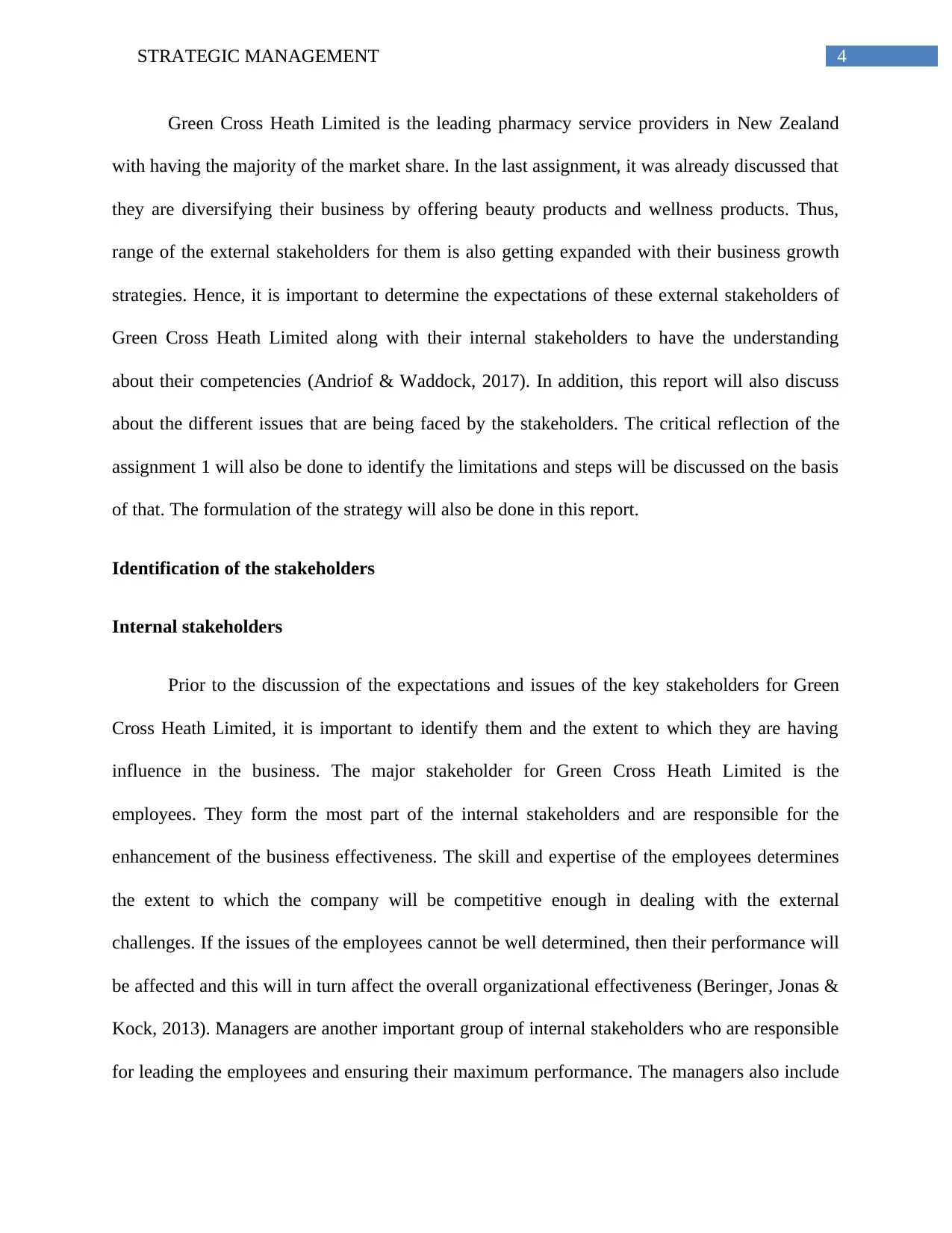
4STRATEGIC MANAGEMENT
Green Cross Heath Limited is the leading pharmacy service providers in New Zealand
with having the majority of the market share. In the last assignment, it was already discussed that
they are diversifying their business by offering beauty products and wellness products. Thus,
range of the external stakeholders for them is also getting expanded with their business growth
strategies. Hence, it is important to determine the expectations of these external stakeholders of
Green Cross Heath Limited along with their internal stakeholders to have the understanding
about their competencies (Andriof & Waddock, 2017). In addition, this report will also discuss
about the different issues that are being faced by the stakeholders. The critical reflection of the
assignment 1 will also be done to identify the limitations and steps will be discussed on the basis
of that. The formulation of the strategy will also be done in this report.
Identification of the stakeholders
Internal stakeholders
Prior to the discussion of the expectations and issues of the key stakeholders for Green
Cross Heath Limited, it is important to identify them and the extent to which they are having
influence in the business. The major stakeholder for Green Cross Heath Limited is the
employees. They form the most part of the internal stakeholders and are responsible for the
enhancement of the business effectiveness. The skill and expertise of the employees determines
the extent to which the company will be competitive enough in dealing with the external
challenges. If the issues of the employees cannot be well determined, then their performance will
be affected and this will in turn affect the overall organizational effectiveness (Beringer, Jonas &
Kock, 2013). Managers are another important group of internal stakeholders who are responsible
for leading the employees and ensuring their maximum performance. The managers also include
Green Cross Heath Limited is the leading pharmacy service providers in New Zealand
with having the majority of the market share. In the last assignment, it was already discussed that
they are diversifying their business by offering beauty products and wellness products. Thus,
range of the external stakeholders for them is also getting expanded with their business growth
strategies. Hence, it is important to determine the expectations of these external stakeholders of
Green Cross Heath Limited along with their internal stakeholders to have the understanding
about their competencies (Andriof & Waddock, 2017). In addition, this report will also discuss
about the different issues that are being faced by the stakeholders. The critical reflection of the
assignment 1 will also be done to identify the limitations and steps will be discussed on the basis
of that. The formulation of the strategy will also be done in this report.
Identification of the stakeholders
Internal stakeholders
Prior to the discussion of the expectations and issues of the key stakeholders for Green
Cross Heath Limited, it is important to identify them and the extent to which they are having
influence in the business. The major stakeholder for Green Cross Heath Limited is the
employees. They form the most part of the internal stakeholders and are responsible for the
enhancement of the business effectiveness. The skill and expertise of the employees determines
the extent to which the company will be competitive enough in dealing with the external
challenges. If the issues of the employees cannot be well determined, then their performance will
be affected and this will in turn affect the overall organizational effectiveness (Beringer, Jonas &
Kock, 2013). Managers are another important group of internal stakeholders who are responsible
for leading the employees and ensuring their maximum performance. The managers also include
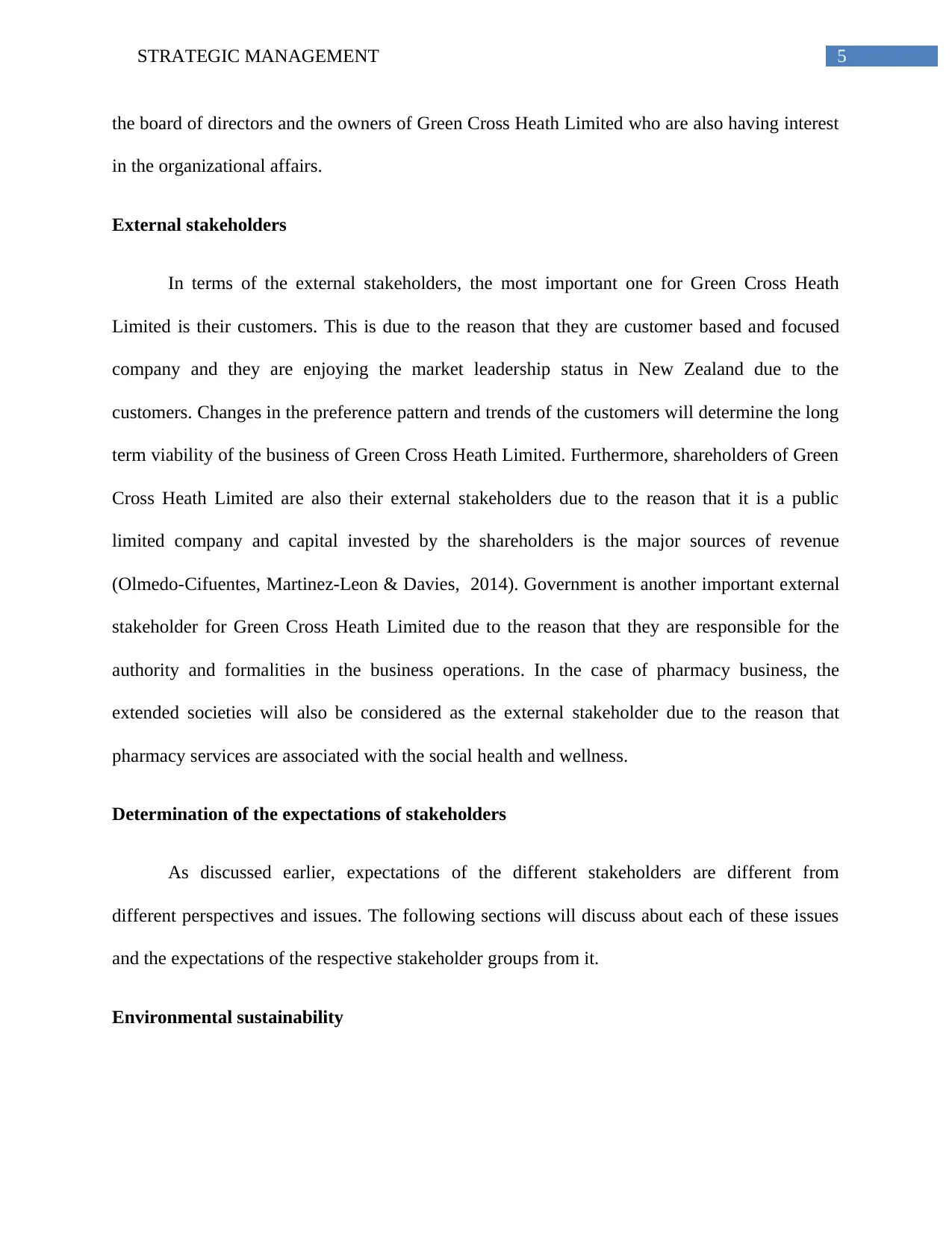
5STRATEGIC MANAGEMENT
the board of directors and the owners of Green Cross Heath Limited who are also having interest
in the organizational affairs.
External stakeholders
In terms of the external stakeholders, the most important one for Green Cross Heath
Limited is their customers. This is due to the reason that they are customer based and focused
company and they are enjoying the market leadership status in New Zealand due to the
customers. Changes in the preference pattern and trends of the customers will determine the long
term viability of the business of Green Cross Heath Limited. Furthermore, shareholders of Green
Cross Heath Limited are also their external stakeholders due to the reason that it is a public
limited company and capital invested by the shareholders is the major sources of revenue
(Olmedo-Cifuentes, Martinez-Leon & Davies, 2014). Government is another important external
stakeholder for Green Cross Heath Limited due to the reason that they are responsible for the
authority and formalities in the business operations. In the case of pharmacy business, the
extended societies will also be considered as the external stakeholder due to the reason that
pharmacy services are associated with the social health and wellness.
Determination of the expectations of stakeholders
As discussed earlier, expectations of the different stakeholders are different from
different perspectives and issues. The following sections will discuss about each of these issues
and the expectations of the respective stakeholder groups from it.
Environmental sustainability
the board of directors and the owners of Green Cross Heath Limited who are also having interest
in the organizational affairs.
External stakeholders
In terms of the external stakeholders, the most important one for Green Cross Heath
Limited is their customers. This is due to the reason that they are customer based and focused
company and they are enjoying the market leadership status in New Zealand due to the
customers. Changes in the preference pattern and trends of the customers will determine the long
term viability of the business of Green Cross Heath Limited. Furthermore, shareholders of Green
Cross Heath Limited are also their external stakeholders due to the reason that it is a public
limited company and capital invested by the shareholders is the major sources of revenue
(Olmedo-Cifuentes, Martinez-Leon & Davies, 2014). Government is another important external
stakeholder for Green Cross Heath Limited due to the reason that they are responsible for the
authority and formalities in the business operations. In the case of pharmacy business, the
extended societies will also be considered as the external stakeholder due to the reason that
pharmacy services are associated with the social health and wellness.
Determination of the expectations of stakeholders
As discussed earlier, expectations of the different stakeholders are different from
different perspectives and issues. The following sections will discuss about each of these issues
and the expectations of the respective stakeholder groups from it.
Environmental sustainability
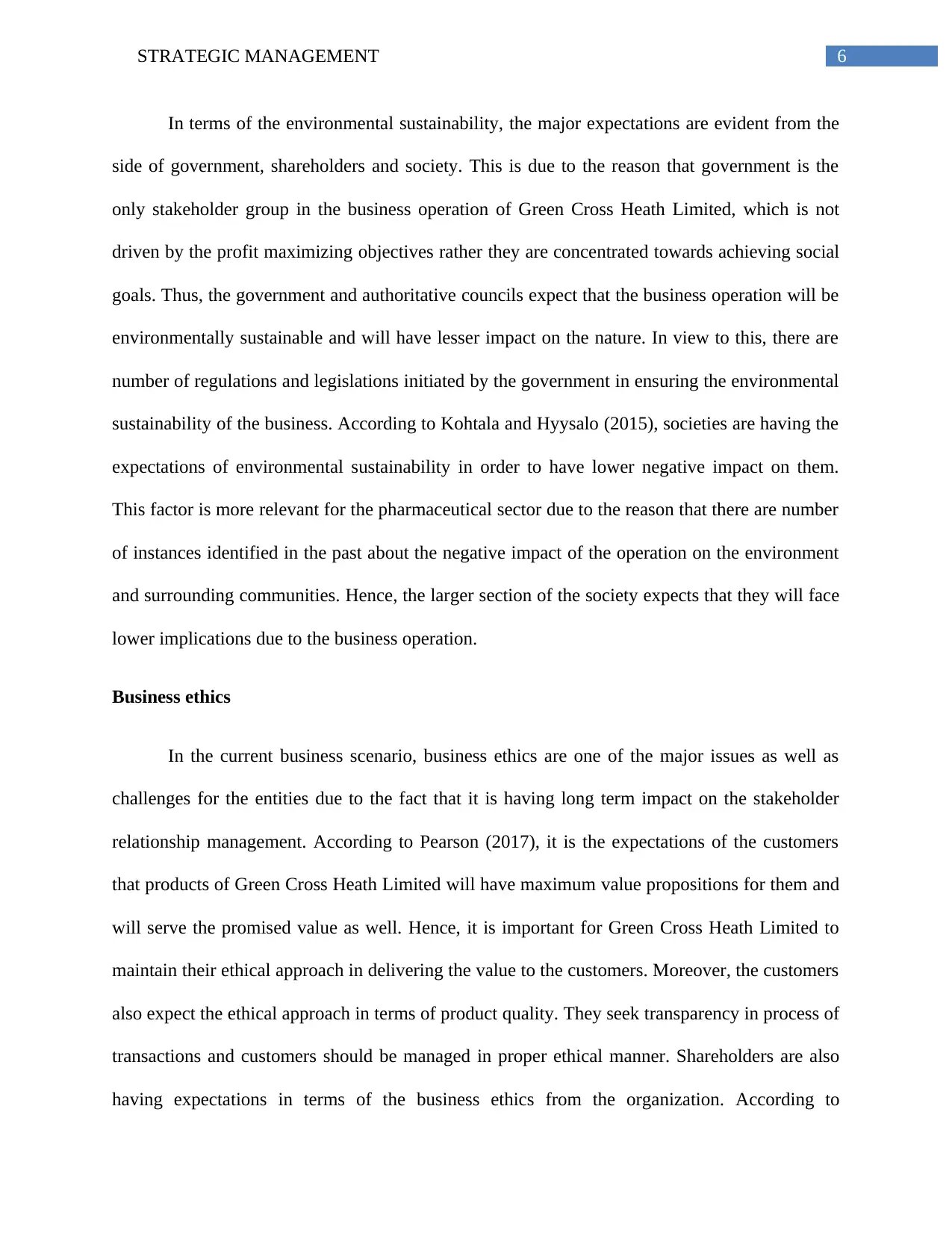
6STRATEGIC MANAGEMENT
In terms of the environmental sustainability, the major expectations are evident from the
side of government, shareholders and society. This is due to the reason that government is the
only stakeholder group in the business operation of Green Cross Heath Limited, which is not
driven by the profit maximizing objectives rather they are concentrated towards achieving social
goals. Thus, the government and authoritative councils expect that the business operation will be
environmentally sustainable and will have lesser impact on the nature. In view to this, there are
number of regulations and legislations initiated by the government in ensuring the environmental
sustainability of the business. According to Kohtala and Hyysalo (2015), societies are having the
expectations of environmental sustainability in order to have lower negative impact on them.
This factor is more relevant for the pharmaceutical sector due to the reason that there are number
of instances identified in the past about the negative impact of the operation on the environment
and surrounding communities. Hence, the larger section of the society expects that they will face
lower implications due to the business operation.
Business ethics
In the current business scenario, business ethics are one of the major issues as well as
challenges for the entities due to the fact that it is having long term impact on the stakeholder
relationship management. According to Pearson (2017), it is the expectations of the customers
that products of Green Cross Heath Limited will have maximum value propositions for them and
will serve the promised value as well. Hence, it is important for Green Cross Heath Limited to
maintain their ethical approach in delivering the value to the customers. Moreover, the customers
also expect the ethical approach in terms of product quality. They seek transparency in process of
transactions and customers should be managed in proper ethical manner. Shareholders are also
having expectations in terms of the business ethics from the organization. According to
In terms of the environmental sustainability, the major expectations are evident from the
side of government, shareholders and society. This is due to the reason that government is the
only stakeholder group in the business operation of Green Cross Heath Limited, which is not
driven by the profit maximizing objectives rather they are concentrated towards achieving social
goals. Thus, the government and authoritative councils expect that the business operation will be
environmentally sustainable and will have lesser impact on the nature. In view to this, there are
number of regulations and legislations initiated by the government in ensuring the environmental
sustainability of the business. According to Kohtala and Hyysalo (2015), societies are having the
expectations of environmental sustainability in order to have lower negative impact on them.
This factor is more relevant for the pharmaceutical sector due to the reason that there are number
of instances identified in the past about the negative impact of the operation on the environment
and surrounding communities. Hence, the larger section of the society expects that they will face
lower implications due to the business operation.
Business ethics
In the current business scenario, business ethics are one of the major issues as well as
challenges for the entities due to the fact that it is having long term impact on the stakeholder
relationship management. According to Pearson (2017), it is the expectations of the customers
that products of Green Cross Heath Limited will have maximum value propositions for them and
will serve the promised value as well. Hence, it is important for Green Cross Heath Limited to
maintain their ethical approach in delivering the value to the customers. Moreover, the customers
also expect the ethical approach in terms of product quality. They seek transparency in process of
transactions and customers should be managed in proper ethical manner. Shareholders are also
having expectations in terms of the business ethics from the organization. According to
Paraphrase This Document
Need a fresh take? Get an instant paraphrase of this document with our AI Paraphraser
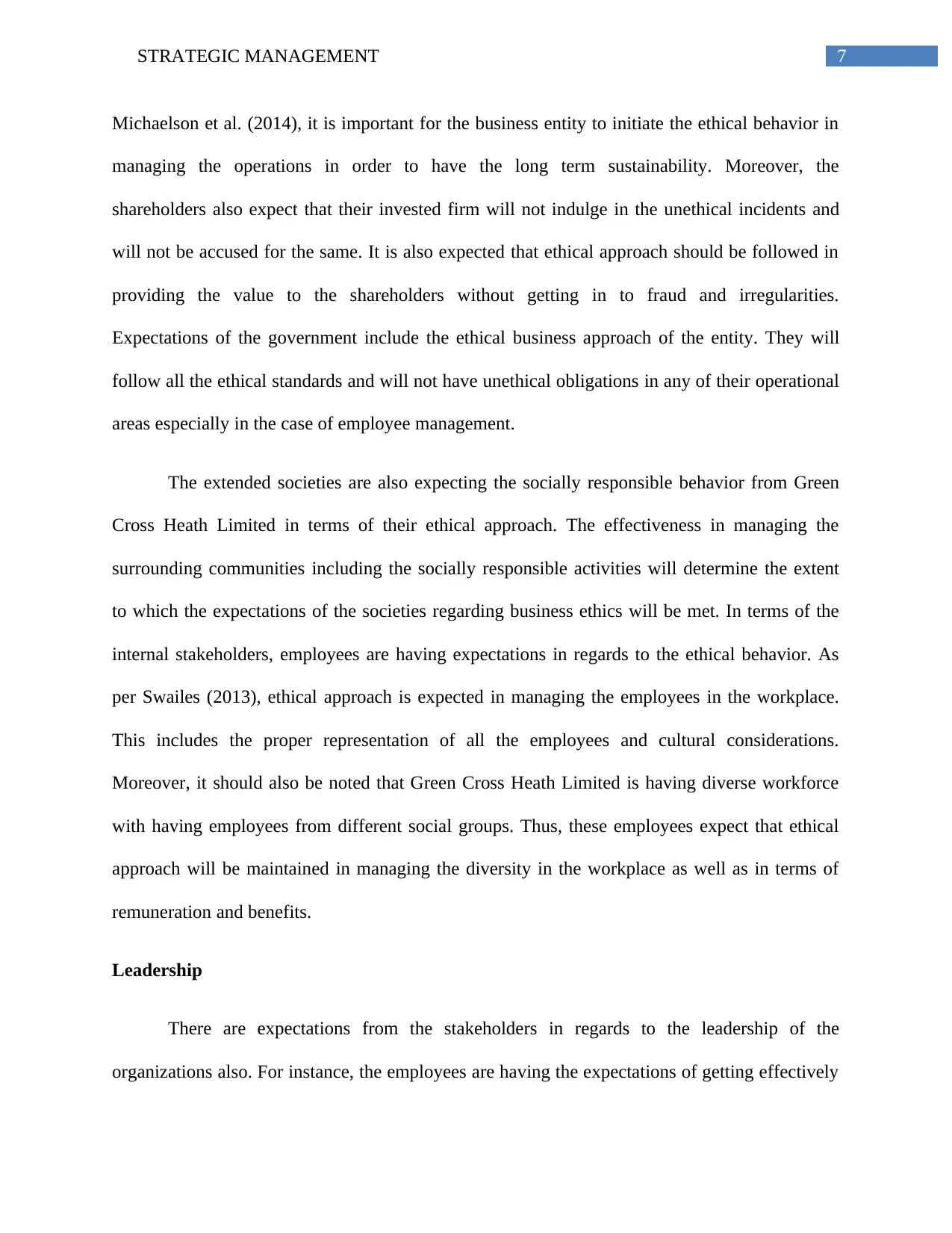
7STRATEGIC MANAGEMENT
Michaelson et al. (2014), it is important for the business entity to initiate the ethical behavior in
managing the operations in order to have the long term sustainability. Moreover, the
shareholders also expect that their invested firm will not indulge in the unethical incidents and
will not be accused for the same. It is also expected that ethical approach should be followed in
providing the value to the shareholders without getting in to fraud and irregularities.
Expectations of the government include the ethical business approach of the entity. They will
follow all the ethical standards and will not have unethical obligations in any of their operational
areas especially in the case of employee management.
The extended societies are also expecting the socially responsible behavior from Green
Cross Heath Limited in terms of their ethical approach. The effectiveness in managing the
surrounding communities including the socially responsible activities will determine the extent
to which the expectations of the societies regarding business ethics will be met. In terms of the
internal stakeholders, employees are having expectations in regards to the ethical behavior. As
per Swailes (2013), ethical approach is expected in managing the employees in the workplace.
This includes the proper representation of all the employees and cultural considerations.
Moreover, it should also be noted that Green Cross Heath Limited is having diverse workforce
with having employees from different social groups. Thus, these employees expect that ethical
approach will be maintained in managing the diversity in the workplace as well as in terms of
remuneration and benefits.
Leadership
There are expectations from the stakeholders in regards to the leadership of the
organizations also. For instance, the employees are having the expectations of getting effectively
Michaelson et al. (2014), it is important for the business entity to initiate the ethical behavior in
managing the operations in order to have the long term sustainability. Moreover, the
shareholders also expect that their invested firm will not indulge in the unethical incidents and
will not be accused for the same. It is also expected that ethical approach should be followed in
providing the value to the shareholders without getting in to fraud and irregularities.
Expectations of the government include the ethical business approach of the entity. They will
follow all the ethical standards and will not have unethical obligations in any of their operational
areas especially in the case of employee management.
The extended societies are also expecting the socially responsible behavior from Green
Cross Heath Limited in terms of their ethical approach. The effectiveness in managing the
surrounding communities including the socially responsible activities will determine the extent
to which the expectations of the societies regarding business ethics will be met. In terms of the
internal stakeholders, employees are having expectations in regards to the ethical behavior. As
per Swailes (2013), ethical approach is expected in managing the employees in the workplace.
This includes the proper representation of all the employees and cultural considerations.
Moreover, it should also be noted that Green Cross Heath Limited is having diverse workforce
with having employees from different social groups. Thus, these employees expect that ethical
approach will be maintained in managing the diversity in the workplace as well as in terms of
remuneration and benefits.
Leadership
There are expectations from the stakeholders in regards to the leadership of the
organizations also. For instance, the employees are having the expectations of getting effectively
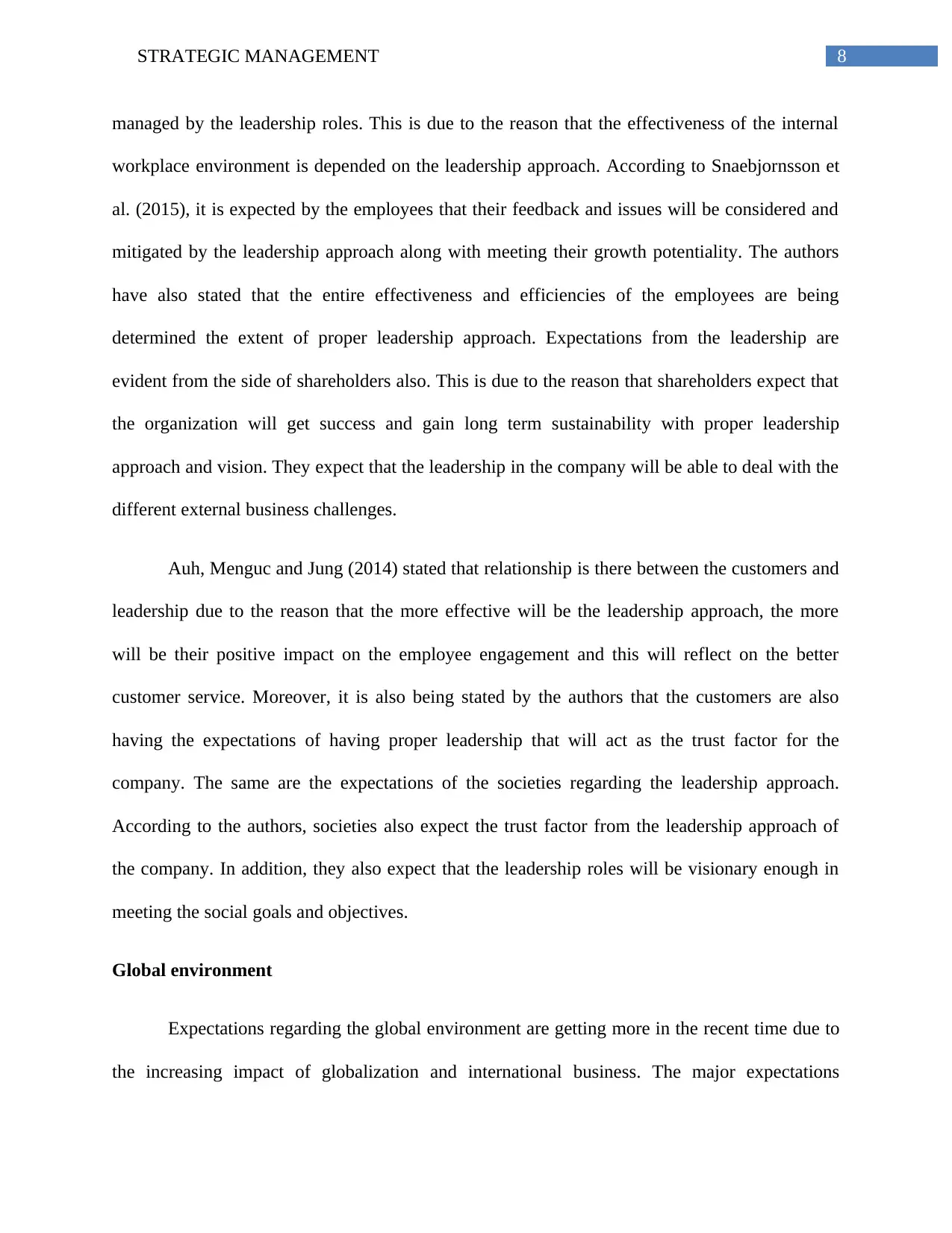
8STRATEGIC MANAGEMENT
managed by the leadership roles. This is due to the reason that the effectiveness of the internal
workplace environment is depended on the leadership approach. According to Snaebjornsson et
al. (2015), it is expected by the employees that their feedback and issues will be considered and
mitigated by the leadership approach along with meeting their growth potentiality. The authors
have also stated that the entire effectiveness and efficiencies of the employees are being
determined the extent of proper leadership approach. Expectations from the leadership are
evident from the side of shareholders also. This is due to the reason that shareholders expect that
the organization will get success and gain long term sustainability with proper leadership
approach and vision. They expect that the leadership in the company will be able to deal with the
different external business challenges.
Auh, Menguc and Jung (2014) stated that relationship is there between the customers and
leadership due to the reason that the more effective will be the leadership approach, the more
will be their positive impact on the employee engagement and this will reflect on the better
customer service. Moreover, it is also being stated by the authors that the customers are also
having the expectations of having proper leadership that will act as the trust factor for the
company. The same are the expectations of the societies regarding the leadership approach.
According to the authors, societies also expect the trust factor from the leadership approach of
the company. In addition, they also expect that the leadership roles will be visionary enough in
meeting the social goals and objectives.
Global environment
Expectations regarding the global environment are getting more in the recent time due to
the increasing impact of globalization and international business. The major expectations
managed by the leadership roles. This is due to the reason that the effectiveness of the internal
workplace environment is depended on the leadership approach. According to Snaebjornsson et
al. (2015), it is expected by the employees that their feedback and issues will be considered and
mitigated by the leadership approach along with meeting their growth potentiality. The authors
have also stated that the entire effectiveness and efficiencies of the employees are being
determined the extent of proper leadership approach. Expectations from the leadership are
evident from the side of shareholders also. This is due to the reason that shareholders expect that
the organization will get success and gain long term sustainability with proper leadership
approach and vision. They expect that the leadership in the company will be able to deal with the
different external business challenges.
Auh, Menguc and Jung (2014) stated that relationship is there between the customers and
leadership due to the reason that the more effective will be the leadership approach, the more
will be their positive impact on the employee engagement and this will reflect on the better
customer service. Moreover, it is also being stated by the authors that the customers are also
having the expectations of having proper leadership that will act as the trust factor for the
company. The same are the expectations of the societies regarding the leadership approach.
According to the authors, societies also expect the trust factor from the leadership approach of
the company. In addition, they also expect that the leadership roles will be visionary enough in
meeting the social goals and objectives.
Global environment
Expectations regarding the global environment are getting more in the recent time due to
the increasing impact of globalization and international business. The major expectations
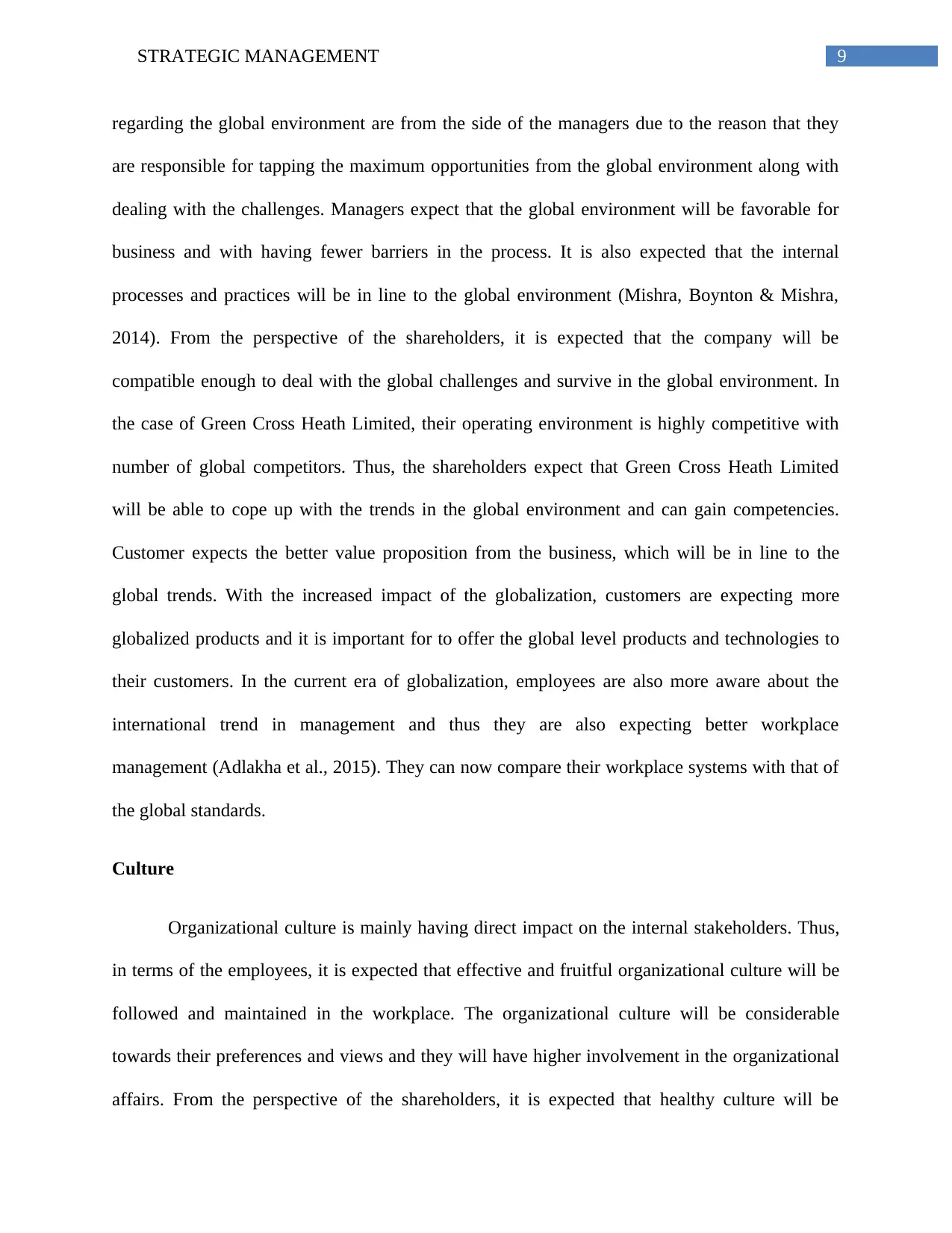
9STRATEGIC MANAGEMENT
regarding the global environment are from the side of the managers due to the reason that they
are responsible for tapping the maximum opportunities from the global environment along with
dealing with the challenges. Managers expect that the global environment will be favorable for
business and with having fewer barriers in the process. It is also expected that the internal
processes and practices will be in line to the global environment (Mishra, Boynton & Mishra,
2014). From the perspective of the shareholders, it is expected that the company will be
compatible enough to deal with the global challenges and survive in the global environment. In
the case of Green Cross Heath Limited, their operating environment is highly competitive with
number of global competitors. Thus, the shareholders expect that Green Cross Heath Limited
will be able to cope up with the trends in the global environment and can gain competencies.
Customer expects the better value proposition from the business, which will be in line to the
global trends. With the increased impact of the globalization, customers are expecting more
globalized products and it is important for to offer the global level products and technologies to
their customers. In the current era of globalization, employees are also more aware about the
international trend in management and thus they are also expecting better workplace
management (Adlakha et al., 2015). They can now compare their workplace systems with that of
the global standards.
Culture
Organizational culture is mainly having direct impact on the internal stakeholders. Thus,
in terms of the employees, it is expected that effective and fruitful organizational culture will be
followed and maintained in the workplace. The organizational culture will be considerable
towards their preferences and views and they will have higher involvement in the organizational
affairs. From the perspective of the shareholders, it is expected that healthy culture will be
regarding the global environment are from the side of the managers due to the reason that they
are responsible for tapping the maximum opportunities from the global environment along with
dealing with the challenges. Managers expect that the global environment will be favorable for
business and with having fewer barriers in the process. It is also expected that the internal
processes and practices will be in line to the global environment (Mishra, Boynton & Mishra,
2014). From the perspective of the shareholders, it is expected that the company will be
compatible enough to deal with the global challenges and survive in the global environment. In
the case of Green Cross Heath Limited, their operating environment is highly competitive with
number of global competitors. Thus, the shareholders expect that Green Cross Heath Limited
will be able to cope up with the trends in the global environment and can gain competencies.
Customer expects the better value proposition from the business, which will be in line to the
global trends. With the increased impact of the globalization, customers are expecting more
globalized products and it is important for to offer the global level products and technologies to
their customers. In the current era of globalization, employees are also more aware about the
international trend in management and thus they are also expecting better workplace
management (Adlakha et al., 2015). They can now compare their workplace systems with that of
the global standards.
Culture
Organizational culture is mainly having direct impact on the internal stakeholders. Thus,
in terms of the employees, it is expected that effective and fruitful organizational culture will be
followed and maintained in the workplace. The organizational culture will be considerable
towards their preferences and views and they will have higher involvement in the organizational
affairs. From the perspective of the shareholders, it is expected that healthy culture will be
Secure Best Marks with AI Grader
Need help grading? Try our AI Grader for instant feedback on your assignments.
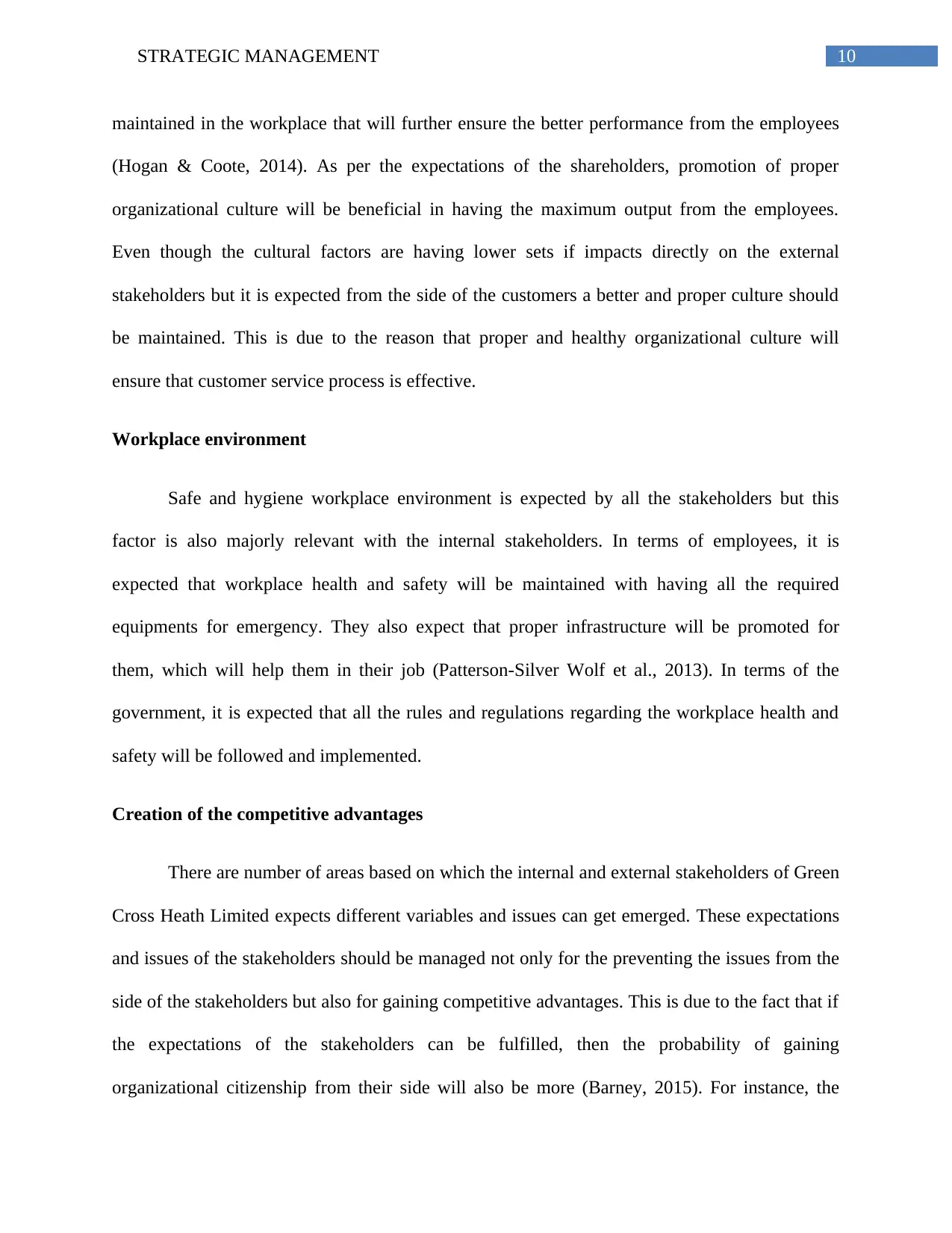
10STRATEGIC MANAGEMENT
maintained in the workplace that will further ensure the better performance from the employees
(Hogan & Coote, 2014). As per the expectations of the shareholders, promotion of proper
organizational culture will be beneficial in having the maximum output from the employees.
Even though the cultural factors are having lower sets if impacts directly on the external
stakeholders but it is expected from the side of the customers a better and proper culture should
be maintained. This is due to the reason that proper and healthy organizational culture will
ensure that customer service process is effective.
Workplace environment
Safe and hygiene workplace environment is expected by all the stakeholders but this
factor is also majorly relevant with the internal stakeholders. In terms of employees, it is
expected that workplace health and safety will be maintained with having all the required
equipments for emergency. They also expect that proper infrastructure will be promoted for
them, which will help them in their job (Patterson-Silver Wolf et al., 2013). In terms of the
government, it is expected that all the rules and regulations regarding the workplace health and
safety will be followed and implemented.
Creation of the competitive advantages
There are number of areas based on which the internal and external stakeholders of Green
Cross Heath Limited expects different variables and issues can get emerged. These expectations
and issues of the stakeholders should be managed not only for the preventing the issues from the
side of the stakeholders but also for gaining competitive advantages. This is due to the fact that if
the expectations of the stakeholders can be fulfilled, then the probability of gaining
organizational citizenship from their side will also be more (Barney, 2015). For instance, the
maintained in the workplace that will further ensure the better performance from the employees
(Hogan & Coote, 2014). As per the expectations of the shareholders, promotion of proper
organizational culture will be beneficial in having the maximum output from the employees.
Even though the cultural factors are having lower sets if impacts directly on the external
stakeholders but it is expected from the side of the customers a better and proper culture should
be maintained. This is due to the reason that proper and healthy organizational culture will
ensure that customer service process is effective.
Workplace environment
Safe and hygiene workplace environment is expected by all the stakeholders but this
factor is also majorly relevant with the internal stakeholders. In terms of employees, it is
expected that workplace health and safety will be maintained with having all the required
equipments for emergency. They also expect that proper infrastructure will be promoted for
them, which will help them in their job (Patterson-Silver Wolf et al., 2013). In terms of the
government, it is expected that all the rules and regulations regarding the workplace health and
safety will be followed and implemented.
Creation of the competitive advantages
There are number of areas based on which the internal and external stakeholders of Green
Cross Heath Limited expects different variables and issues can get emerged. These expectations
and issues of the stakeholders should be managed not only for the preventing the issues from the
side of the stakeholders but also for gaining competitive advantages. This is due to the fact that if
the expectations of the stakeholders can be fulfilled, then the probability of gaining
organizational citizenship from their side will also be more (Barney, 2015). For instance, the
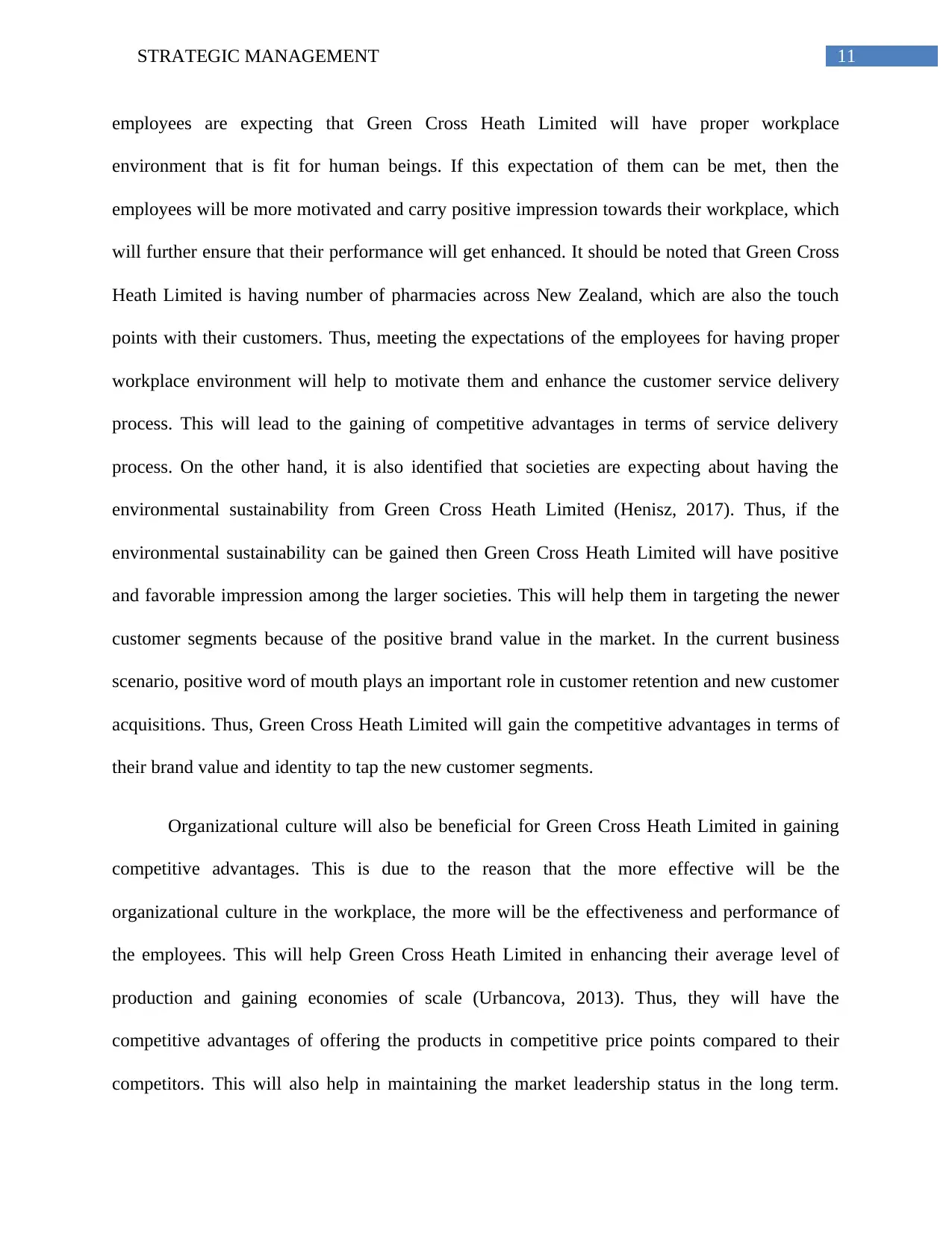
11STRATEGIC MANAGEMENT
employees are expecting that Green Cross Heath Limited will have proper workplace
environment that is fit for human beings. If this expectation of them can be met, then the
employees will be more motivated and carry positive impression towards their workplace, which
will further ensure that their performance will get enhanced. It should be noted that Green Cross
Heath Limited is having number of pharmacies across New Zealand, which are also the touch
points with their customers. Thus, meeting the expectations of the employees for having proper
workplace environment will help to motivate them and enhance the customer service delivery
process. This will lead to the gaining of competitive advantages in terms of service delivery
process. On the other hand, it is also identified that societies are expecting about having the
environmental sustainability from Green Cross Heath Limited (Henisz, 2017). Thus, if the
environmental sustainability can be gained then Green Cross Heath Limited will have positive
and favorable impression among the larger societies. This will help them in targeting the newer
customer segments because of the positive brand value in the market. In the current business
scenario, positive word of mouth plays an important role in customer retention and new customer
acquisitions. Thus, Green Cross Heath Limited will gain the competitive advantages in terms of
their brand value and identity to tap the new customer segments.
Organizational culture will also be beneficial for Green Cross Heath Limited in gaining
competitive advantages. This is due to the reason that the more effective will be the
organizational culture in the workplace, the more will be the effectiveness and performance of
the employees. This will help Green Cross Heath Limited in enhancing their average level of
production and gaining economies of scale (Urbancova, 2013). Thus, they will have the
competitive advantages of offering the products in competitive price points compared to their
competitors. This will also help in maintaining the market leadership status in the long term.
employees are expecting that Green Cross Heath Limited will have proper workplace
environment that is fit for human beings. If this expectation of them can be met, then the
employees will be more motivated and carry positive impression towards their workplace, which
will further ensure that their performance will get enhanced. It should be noted that Green Cross
Heath Limited is having number of pharmacies across New Zealand, which are also the touch
points with their customers. Thus, meeting the expectations of the employees for having proper
workplace environment will help to motivate them and enhance the customer service delivery
process. This will lead to the gaining of competitive advantages in terms of service delivery
process. On the other hand, it is also identified that societies are expecting about having the
environmental sustainability from Green Cross Heath Limited (Henisz, 2017). Thus, if the
environmental sustainability can be gained then Green Cross Heath Limited will have positive
and favorable impression among the larger societies. This will help them in targeting the newer
customer segments because of the positive brand value in the market. In the current business
scenario, positive word of mouth plays an important role in customer retention and new customer
acquisitions. Thus, Green Cross Heath Limited will gain the competitive advantages in terms of
their brand value and identity to tap the new customer segments.
Organizational culture will also be beneficial for Green Cross Heath Limited in gaining
competitive advantages. This is due to the reason that the more effective will be the
organizational culture in the workplace, the more will be the effectiveness and performance of
the employees. This will help Green Cross Heath Limited in enhancing their average level of
production and gaining economies of scale (Urbancova, 2013). Thus, they will have the
competitive advantages of offering the products in competitive price points compared to their
competitors. This will also help in maintaining the market leadership status in the long term.
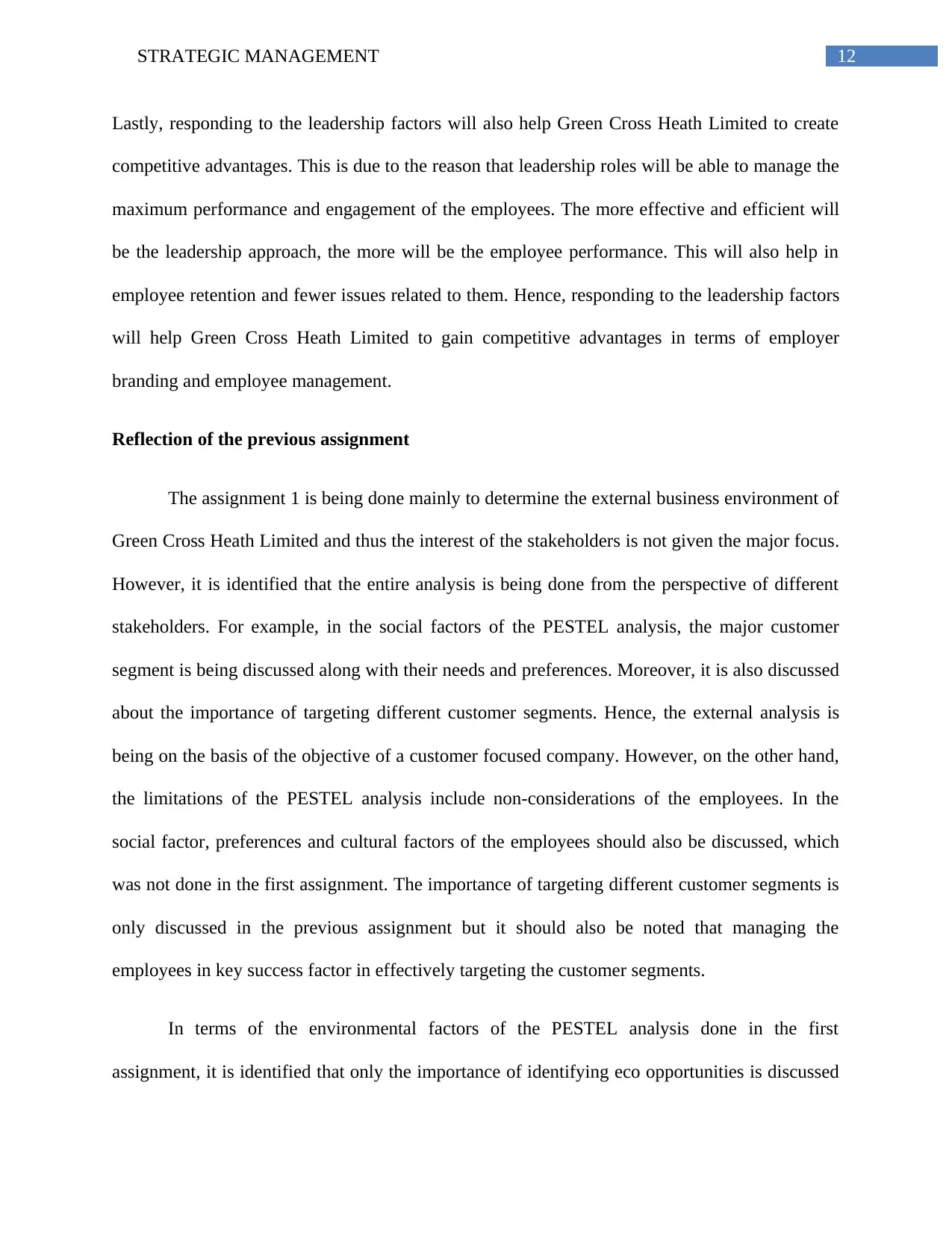
12STRATEGIC MANAGEMENT
Lastly, responding to the leadership factors will also help Green Cross Heath Limited to create
competitive advantages. This is due to the reason that leadership roles will be able to manage the
maximum performance and engagement of the employees. The more effective and efficient will
be the leadership approach, the more will be the employee performance. This will also help in
employee retention and fewer issues related to them. Hence, responding to the leadership factors
will help Green Cross Heath Limited to gain competitive advantages in terms of employer
branding and employee management.
Reflection of the previous assignment
The assignment 1 is being done mainly to determine the external business environment of
Green Cross Heath Limited and thus the interest of the stakeholders is not given the major focus.
However, it is identified that the entire analysis is being done from the perspective of different
stakeholders. For example, in the social factors of the PESTEL analysis, the major customer
segment is being discussed along with their needs and preferences. Moreover, it is also discussed
about the importance of targeting different customer segments. Hence, the external analysis is
being on the basis of the objective of a customer focused company. However, on the other hand,
the limitations of the PESTEL analysis include non-considerations of the employees. In the
social factor, preferences and cultural factors of the employees should also be discussed, which
was not done in the first assignment. The importance of targeting different customer segments is
only discussed in the previous assignment but it should also be noted that managing the
employees in key success factor in effectively targeting the customer segments.
In terms of the environmental factors of the PESTEL analysis done in the first
assignment, it is identified that only the importance of identifying eco opportunities is discussed
Lastly, responding to the leadership factors will also help Green Cross Heath Limited to create
competitive advantages. This is due to the reason that leadership roles will be able to manage the
maximum performance and engagement of the employees. The more effective and efficient will
be the leadership approach, the more will be the employee performance. This will also help in
employee retention and fewer issues related to them. Hence, responding to the leadership factors
will help Green Cross Heath Limited to gain competitive advantages in terms of employer
branding and employee management.
Reflection of the previous assignment
The assignment 1 is being done mainly to determine the external business environment of
Green Cross Heath Limited and thus the interest of the stakeholders is not given the major focus.
However, it is identified that the entire analysis is being done from the perspective of different
stakeholders. For example, in the social factors of the PESTEL analysis, the major customer
segment is being discussed along with their needs and preferences. Moreover, it is also discussed
about the importance of targeting different customer segments. Hence, the external analysis is
being on the basis of the objective of a customer focused company. However, on the other hand,
the limitations of the PESTEL analysis include non-considerations of the employees. In the
social factor, preferences and cultural factors of the employees should also be discussed, which
was not done in the first assignment. The importance of targeting different customer segments is
only discussed in the previous assignment but it should also be noted that managing the
employees in key success factor in effectively targeting the customer segments.
In terms of the environmental factors of the PESTEL analysis done in the first
assignment, it is identified that only the importance of identifying eco opportunities is discussed
Paraphrase This Document
Need a fresh take? Get an instant paraphrase of this document with our AI Paraphraser
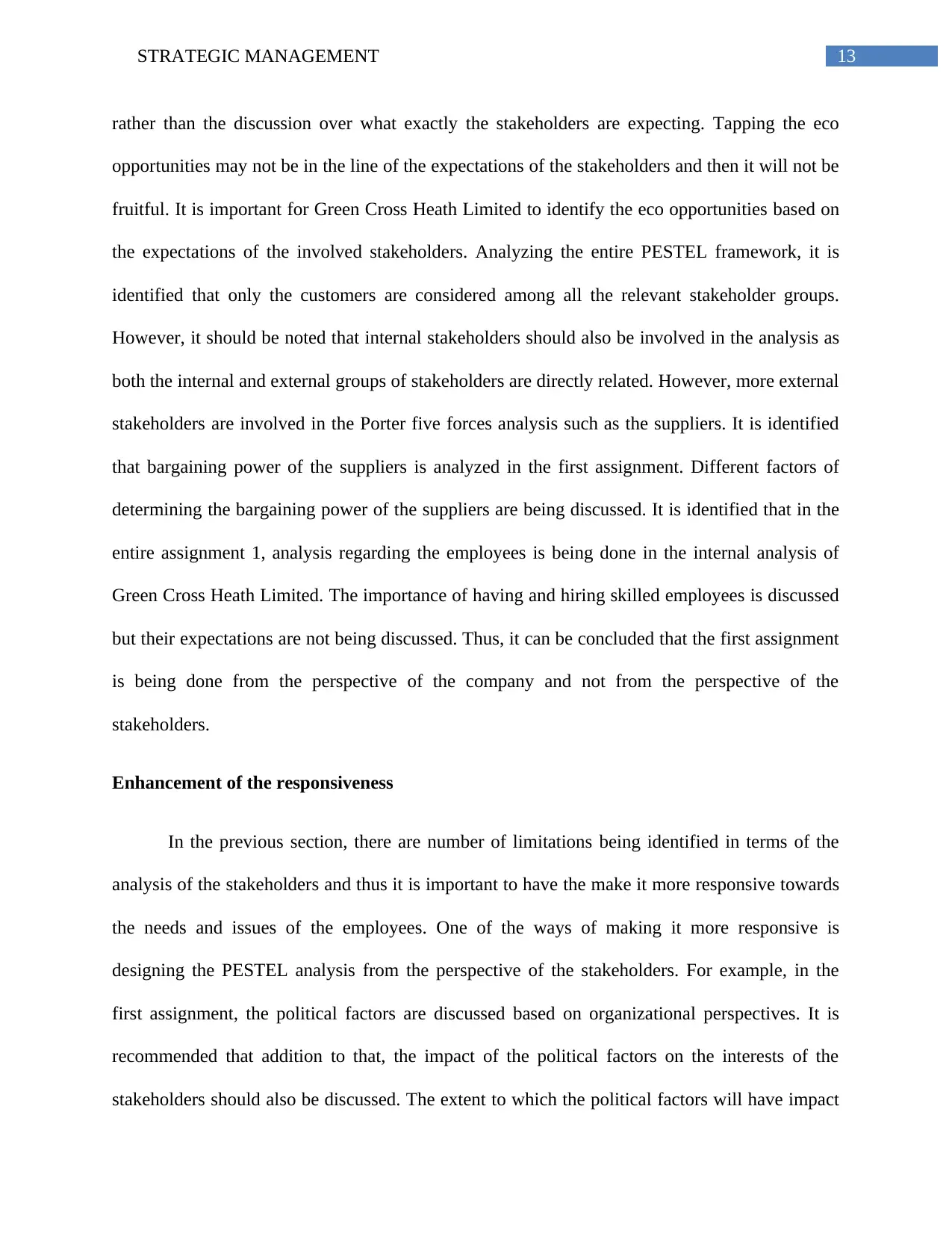
13STRATEGIC MANAGEMENT
rather than the discussion over what exactly the stakeholders are expecting. Tapping the eco
opportunities may not be in the line of the expectations of the stakeholders and then it will not be
fruitful. It is important for Green Cross Heath Limited to identify the eco opportunities based on
the expectations of the involved stakeholders. Analyzing the entire PESTEL framework, it is
identified that only the customers are considered among all the relevant stakeholder groups.
However, it should be noted that internal stakeholders should also be involved in the analysis as
both the internal and external groups of stakeholders are directly related. However, more external
stakeholders are involved in the Porter five forces analysis such as the suppliers. It is identified
that bargaining power of the suppliers is analyzed in the first assignment. Different factors of
determining the bargaining power of the suppliers are being discussed. It is identified that in the
entire assignment 1, analysis regarding the employees is being done in the internal analysis of
Green Cross Heath Limited. The importance of having and hiring skilled employees is discussed
but their expectations are not being discussed. Thus, it can be concluded that the first assignment
is being done from the perspective of the company and not from the perspective of the
stakeholders.
Enhancement of the responsiveness
In the previous section, there are number of limitations being identified in terms of the
analysis of the stakeholders and thus it is important to have the make it more responsive towards
the needs and issues of the employees. One of the ways of making it more responsive is
designing the PESTEL analysis from the perspective of the stakeholders. For example, in the
first assignment, the political factors are discussed based on organizational perspectives. It is
recommended that addition to that, the impact of the political factors on the interests of the
stakeholders should also be discussed. The extent to which the political factors will have impact
rather than the discussion over what exactly the stakeholders are expecting. Tapping the eco
opportunities may not be in the line of the expectations of the stakeholders and then it will not be
fruitful. It is important for Green Cross Heath Limited to identify the eco opportunities based on
the expectations of the involved stakeholders. Analyzing the entire PESTEL framework, it is
identified that only the customers are considered among all the relevant stakeholder groups.
However, it should be noted that internal stakeholders should also be involved in the analysis as
both the internal and external groups of stakeholders are directly related. However, more external
stakeholders are involved in the Porter five forces analysis such as the suppliers. It is identified
that bargaining power of the suppliers is analyzed in the first assignment. Different factors of
determining the bargaining power of the suppliers are being discussed. It is identified that in the
entire assignment 1, analysis regarding the employees is being done in the internal analysis of
Green Cross Heath Limited. The importance of having and hiring skilled employees is discussed
but their expectations are not being discussed. Thus, it can be concluded that the first assignment
is being done from the perspective of the company and not from the perspective of the
stakeholders.
Enhancement of the responsiveness
In the previous section, there are number of limitations being identified in terms of the
analysis of the stakeholders and thus it is important to have the make it more responsive towards
the needs and issues of the employees. One of the ways of making it more responsive is
designing the PESTEL analysis from the perspective of the stakeholders. For example, in the
first assignment, the political factors are discussed based on organizational perspectives. It is
recommended that addition to that, the impact of the political factors on the interests of the
stakeholders should also be discussed. The extent to which the political factors will have impact
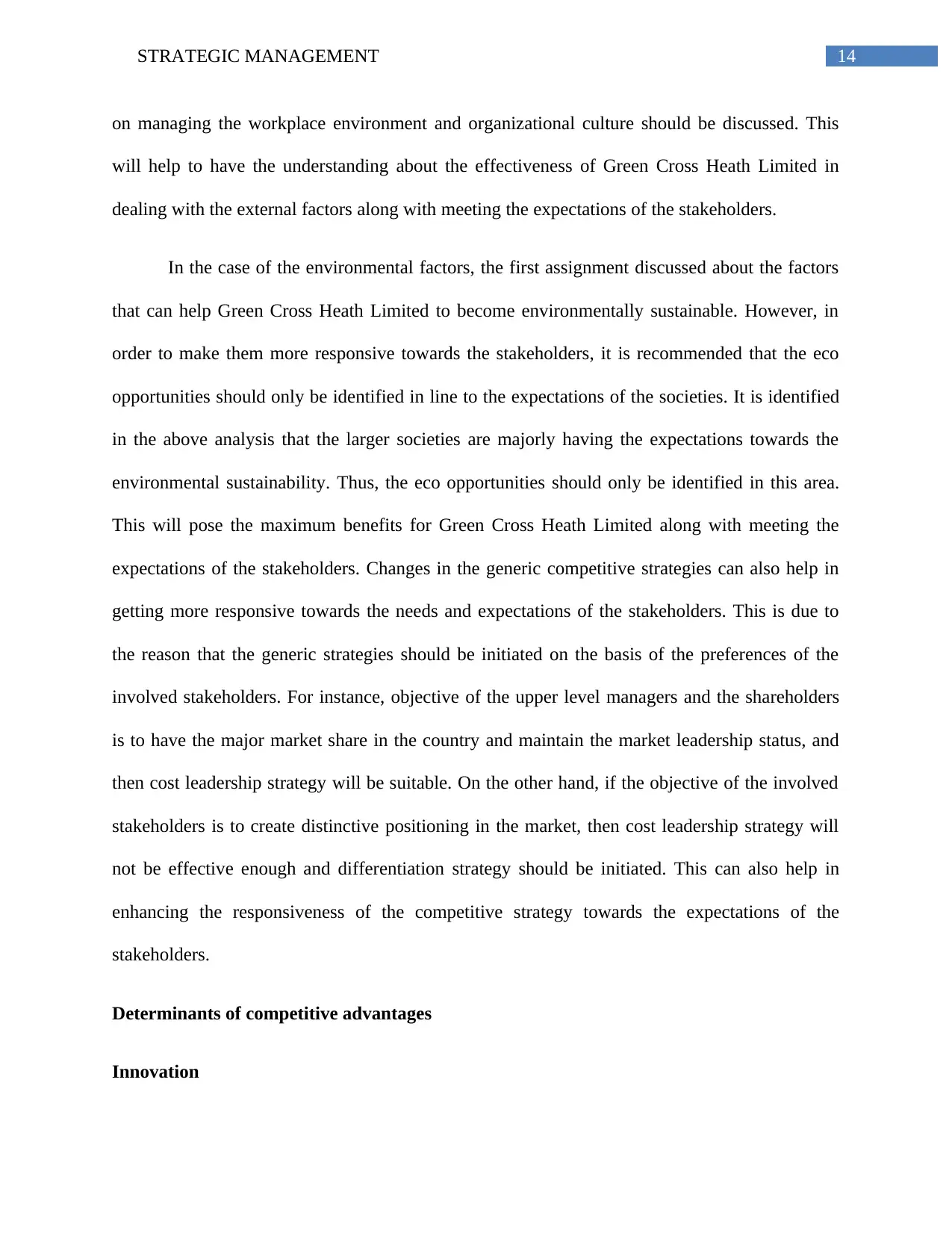
14STRATEGIC MANAGEMENT
on managing the workplace environment and organizational culture should be discussed. This
will help to have the understanding about the effectiveness of Green Cross Heath Limited in
dealing with the external factors along with meeting the expectations of the stakeholders.
In the case of the environmental factors, the first assignment discussed about the factors
that can help Green Cross Heath Limited to become environmentally sustainable. However, in
order to make them more responsive towards the stakeholders, it is recommended that the eco
opportunities should only be identified in line to the expectations of the societies. It is identified
in the above analysis that the larger societies are majorly having the expectations towards the
environmental sustainability. Thus, the eco opportunities should only be identified in this area.
This will pose the maximum benefits for Green Cross Heath Limited along with meeting the
expectations of the stakeholders. Changes in the generic competitive strategies can also help in
getting more responsive towards the needs and expectations of the stakeholders. This is due to
the reason that the generic strategies should be initiated on the basis of the preferences of the
involved stakeholders. For instance, objective of the upper level managers and the shareholders
is to have the major market share in the country and maintain the market leadership status, and
then cost leadership strategy will be suitable. On the other hand, if the objective of the involved
stakeholders is to create distinctive positioning in the market, then cost leadership strategy will
not be effective enough and differentiation strategy should be initiated. This can also help in
enhancing the responsiveness of the competitive strategy towards the expectations of the
stakeholders.
Determinants of competitive advantages
Innovation
on managing the workplace environment and organizational culture should be discussed. This
will help to have the understanding about the effectiveness of Green Cross Heath Limited in
dealing with the external factors along with meeting the expectations of the stakeholders.
In the case of the environmental factors, the first assignment discussed about the factors
that can help Green Cross Heath Limited to become environmentally sustainable. However, in
order to make them more responsive towards the stakeholders, it is recommended that the eco
opportunities should only be identified in line to the expectations of the societies. It is identified
in the above analysis that the larger societies are majorly having the expectations towards the
environmental sustainability. Thus, the eco opportunities should only be identified in this area.
This will pose the maximum benefits for Green Cross Heath Limited along with meeting the
expectations of the stakeholders. Changes in the generic competitive strategies can also help in
getting more responsive towards the needs and expectations of the stakeholders. This is due to
the reason that the generic strategies should be initiated on the basis of the preferences of the
involved stakeholders. For instance, objective of the upper level managers and the shareholders
is to have the major market share in the country and maintain the market leadership status, and
then cost leadership strategy will be suitable. On the other hand, if the objective of the involved
stakeholders is to create distinctive positioning in the market, then cost leadership strategy will
not be effective enough and differentiation strategy should be initiated. This can also help in
enhancing the responsiveness of the competitive strategy towards the expectations of the
stakeholders.
Determinants of competitive advantages
Innovation
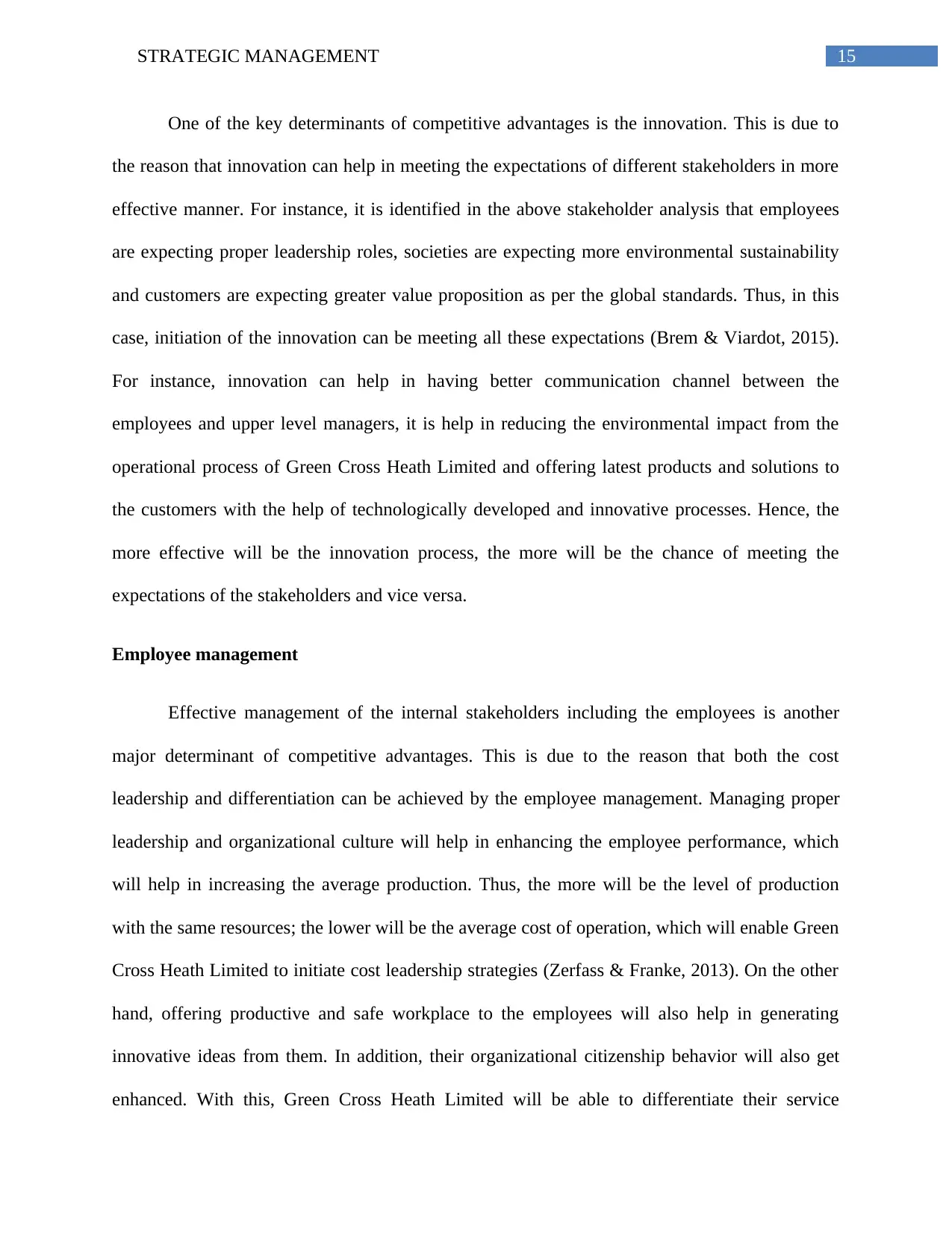
15STRATEGIC MANAGEMENT
One of the key determinants of competitive advantages is the innovation. This is due to
the reason that innovation can help in meeting the expectations of different stakeholders in more
effective manner. For instance, it is identified in the above stakeholder analysis that employees
are expecting proper leadership roles, societies are expecting more environmental sustainability
and customers are expecting greater value proposition as per the global standards. Thus, in this
case, initiation of the innovation can be meeting all these expectations (Brem & Viardot, 2015).
For instance, innovation can help in having better communication channel between the
employees and upper level managers, it is help in reducing the environmental impact from the
operational process of Green Cross Heath Limited and offering latest products and solutions to
the customers with the help of technologically developed and innovative processes. Hence, the
more effective will be the innovation process, the more will be the chance of meeting the
expectations of the stakeholders and vice versa.
Employee management
Effective management of the internal stakeholders including the employees is another
major determinant of competitive advantages. This is due to the reason that both the cost
leadership and differentiation can be achieved by the employee management. Managing proper
leadership and organizational culture will help in enhancing the employee performance, which
will help in increasing the average production. Thus, the more will be the level of production
with the same resources; the lower will be the average cost of operation, which will enable Green
Cross Heath Limited to initiate cost leadership strategies (Zerfass & Franke, 2013). On the other
hand, offering productive and safe workplace to the employees will also help in generating
innovative ideas from them. In addition, their organizational citizenship behavior will also get
enhanced. With this, Green Cross Heath Limited will be able to differentiate their service
One of the key determinants of competitive advantages is the innovation. This is due to
the reason that innovation can help in meeting the expectations of different stakeholders in more
effective manner. For instance, it is identified in the above stakeholder analysis that employees
are expecting proper leadership roles, societies are expecting more environmental sustainability
and customers are expecting greater value proposition as per the global standards. Thus, in this
case, initiation of the innovation can be meeting all these expectations (Brem & Viardot, 2015).
For instance, innovation can help in having better communication channel between the
employees and upper level managers, it is help in reducing the environmental impact from the
operational process of Green Cross Heath Limited and offering latest products and solutions to
the customers with the help of technologically developed and innovative processes. Hence, the
more effective will be the innovation process, the more will be the chance of meeting the
expectations of the stakeholders and vice versa.
Employee management
Effective management of the internal stakeholders including the employees is another
major determinant of competitive advantages. This is due to the reason that both the cost
leadership and differentiation can be achieved by the employee management. Managing proper
leadership and organizational culture will help in enhancing the employee performance, which
will help in increasing the average production. Thus, the more will be the level of production
with the same resources; the lower will be the average cost of operation, which will enable Green
Cross Heath Limited to initiate cost leadership strategies (Zerfass & Franke, 2013). On the other
hand, offering productive and safe workplace to the employees will also help in generating
innovative ideas from them. In addition, their organizational citizenship behavior will also get
enhanced. With this, Green Cross Heath Limited will be able to differentiate their service
Secure Best Marks with AI Grader
Need help grading? Try our AI Grader for instant feedback on your assignments.
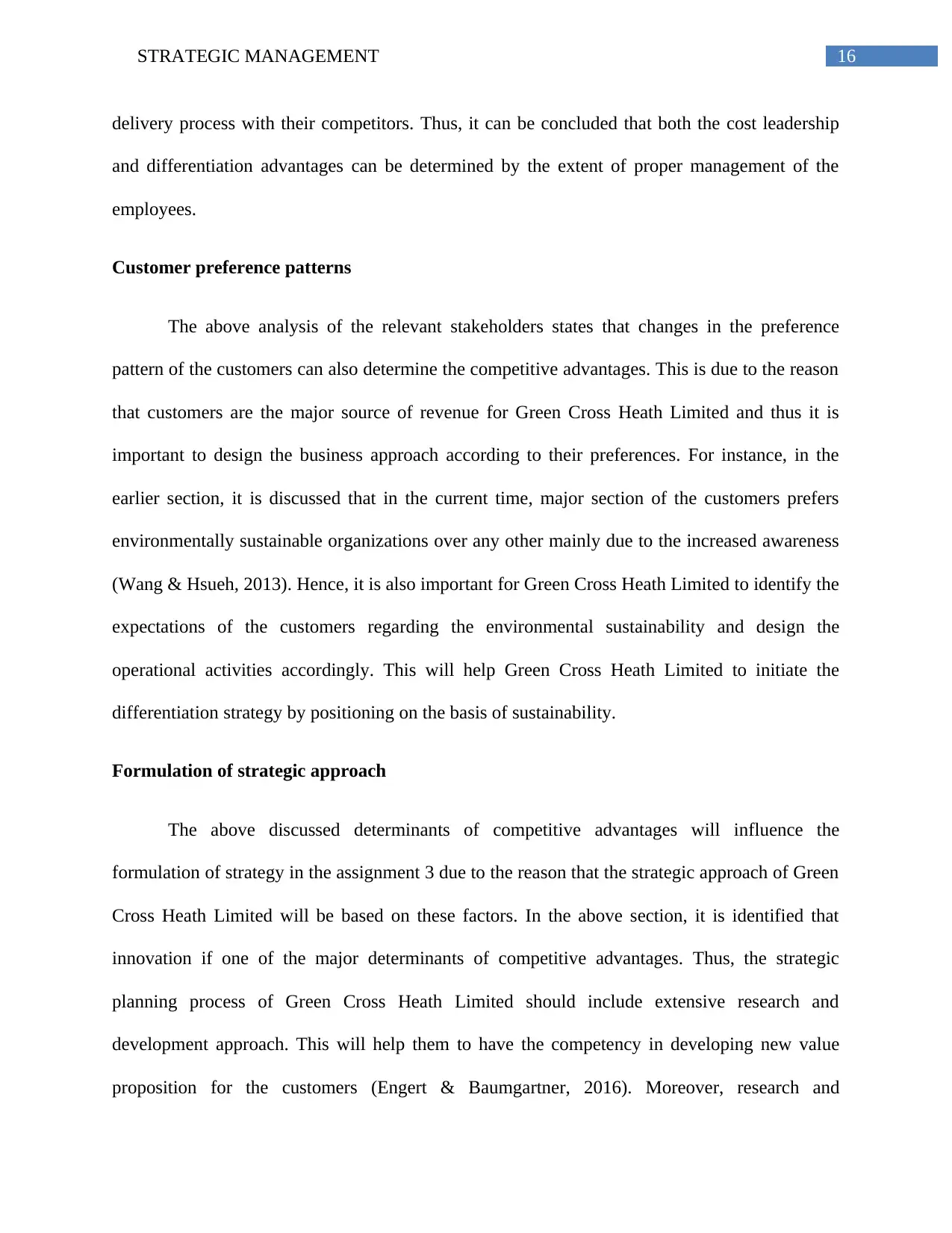
16STRATEGIC MANAGEMENT
delivery process with their competitors. Thus, it can be concluded that both the cost leadership
and differentiation advantages can be determined by the extent of proper management of the
employees.
Customer preference patterns
The above analysis of the relevant stakeholders states that changes in the preference
pattern of the customers can also determine the competitive advantages. This is due to the reason
that customers are the major source of revenue for Green Cross Heath Limited and thus it is
important to design the business approach according to their preferences. For instance, in the
earlier section, it is discussed that in the current time, major section of the customers prefers
environmentally sustainable organizations over any other mainly due to the increased awareness
(Wang & Hsueh, 2013). Hence, it is also important for Green Cross Heath Limited to identify the
expectations of the customers regarding the environmental sustainability and design the
operational activities accordingly. This will help Green Cross Heath Limited to initiate the
differentiation strategy by positioning on the basis of sustainability.
Formulation of strategic approach
The above discussed determinants of competitive advantages will influence the
formulation of strategy in the assignment 3 due to the reason that the strategic approach of Green
Cross Heath Limited will be based on these factors. In the above section, it is identified that
innovation if one of the major determinants of competitive advantages. Thus, the strategic
planning process of Green Cross Heath Limited should include extensive research and
development approach. This will help them to have the competency in developing new value
proposition for the customers (Engert & Baumgartner, 2016). Moreover, research and
delivery process with their competitors. Thus, it can be concluded that both the cost leadership
and differentiation advantages can be determined by the extent of proper management of the
employees.
Customer preference patterns
The above analysis of the relevant stakeholders states that changes in the preference
pattern of the customers can also determine the competitive advantages. This is due to the reason
that customers are the major source of revenue for Green Cross Heath Limited and thus it is
important to design the business approach according to their preferences. For instance, in the
earlier section, it is discussed that in the current time, major section of the customers prefers
environmentally sustainable organizations over any other mainly due to the increased awareness
(Wang & Hsueh, 2013). Hence, it is also important for Green Cross Heath Limited to identify the
expectations of the customers regarding the environmental sustainability and design the
operational activities accordingly. This will help Green Cross Heath Limited to initiate the
differentiation strategy by positioning on the basis of sustainability.
Formulation of strategic approach
The above discussed determinants of competitive advantages will influence the
formulation of strategy in the assignment 3 due to the reason that the strategic approach of Green
Cross Heath Limited will be based on these factors. In the above section, it is identified that
innovation if one of the major determinants of competitive advantages. Thus, the strategic
planning process of Green Cross Heath Limited should include extensive research and
development approach. This will help them to have the competency in developing new value
proposition for the customers (Engert & Baumgartner, 2016). Moreover, research and
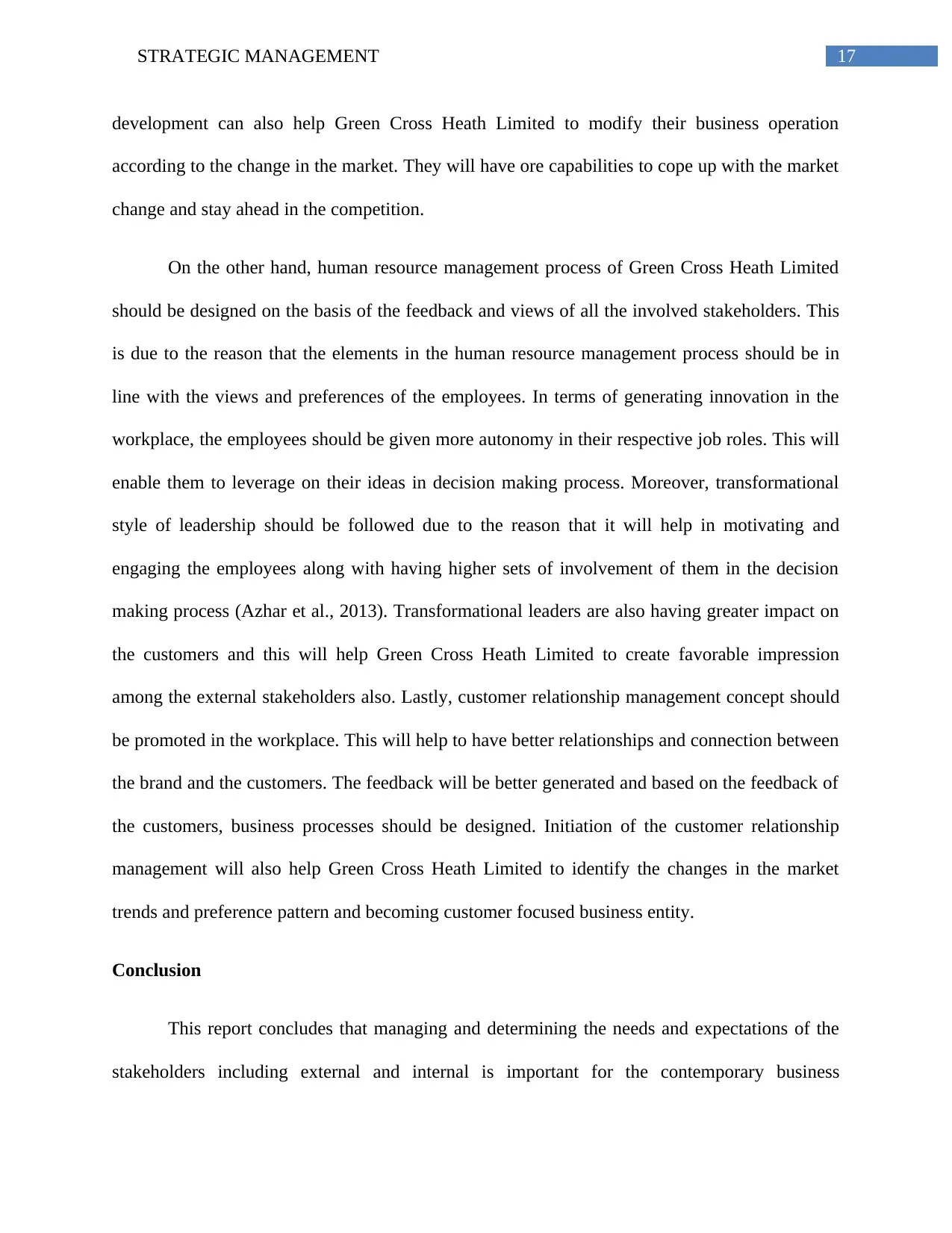
17STRATEGIC MANAGEMENT
development can also help Green Cross Heath Limited to modify their business operation
according to the change in the market. They will have ore capabilities to cope up with the market
change and stay ahead in the competition.
On the other hand, human resource management process of Green Cross Heath Limited
should be designed on the basis of the feedback and views of all the involved stakeholders. This
is due to the reason that the elements in the human resource management process should be in
line with the views and preferences of the employees. In terms of generating innovation in the
workplace, the employees should be given more autonomy in their respective job roles. This will
enable them to leverage on their ideas in decision making process. Moreover, transformational
style of leadership should be followed due to the reason that it will help in motivating and
engaging the employees along with having higher sets of involvement of them in the decision
making process (Azhar et al., 2013). Transformational leaders are also having greater impact on
the customers and this will help Green Cross Heath Limited to create favorable impression
among the external stakeholders also. Lastly, customer relationship management concept should
be promoted in the workplace. This will help to have better relationships and connection between
the brand and the customers. The feedback will be better generated and based on the feedback of
the customers, business processes should be designed. Initiation of the customer relationship
management will also help Green Cross Heath Limited to identify the changes in the market
trends and preference pattern and becoming customer focused business entity.
Conclusion
This report concludes that managing and determining the needs and expectations of the
stakeholders including external and internal is important for the contemporary business
development can also help Green Cross Heath Limited to modify their business operation
according to the change in the market. They will have ore capabilities to cope up with the market
change and stay ahead in the competition.
On the other hand, human resource management process of Green Cross Heath Limited
should be designed on the basis of the feedback and views of all the involved stakeholders. This
is due to the reason that the elements in the human resource management process should be in
line with the views and preferences of the employees. In terms of generating innovation in the
workplace, the employees should be given more autonomy in their respective job roles. This will
enable them to leverage on their ideas in decision making process. Moreover, transformational
style of leadership should be followed due to the reason that it will help in motivating and
engaging the employees along with having higher sets of involvement of them in the decision
making process (Azhar et al., 2013). Transformational leaders are also having greater impact on
the customers and this will help Green Cross Heath Limited to create favorable impression
among the external stakeholders also. Lastly, customer relationship management concept should
be promoted in the workplace. This will help to have better relationships and connection between
the brand and the customers. The feedback will be better generated and based on the feedback of
the customers, business processes should be designed. Initiation of the customer relationship
management will also help Green Cross Heath Limited to identify the changes in the market
trends and preference pattern and becoming customer focused business entity.
Conclusion
This report concludes that managing and determining the needs and expectations of the
stakeholders including external and internal is important for the contemporary business
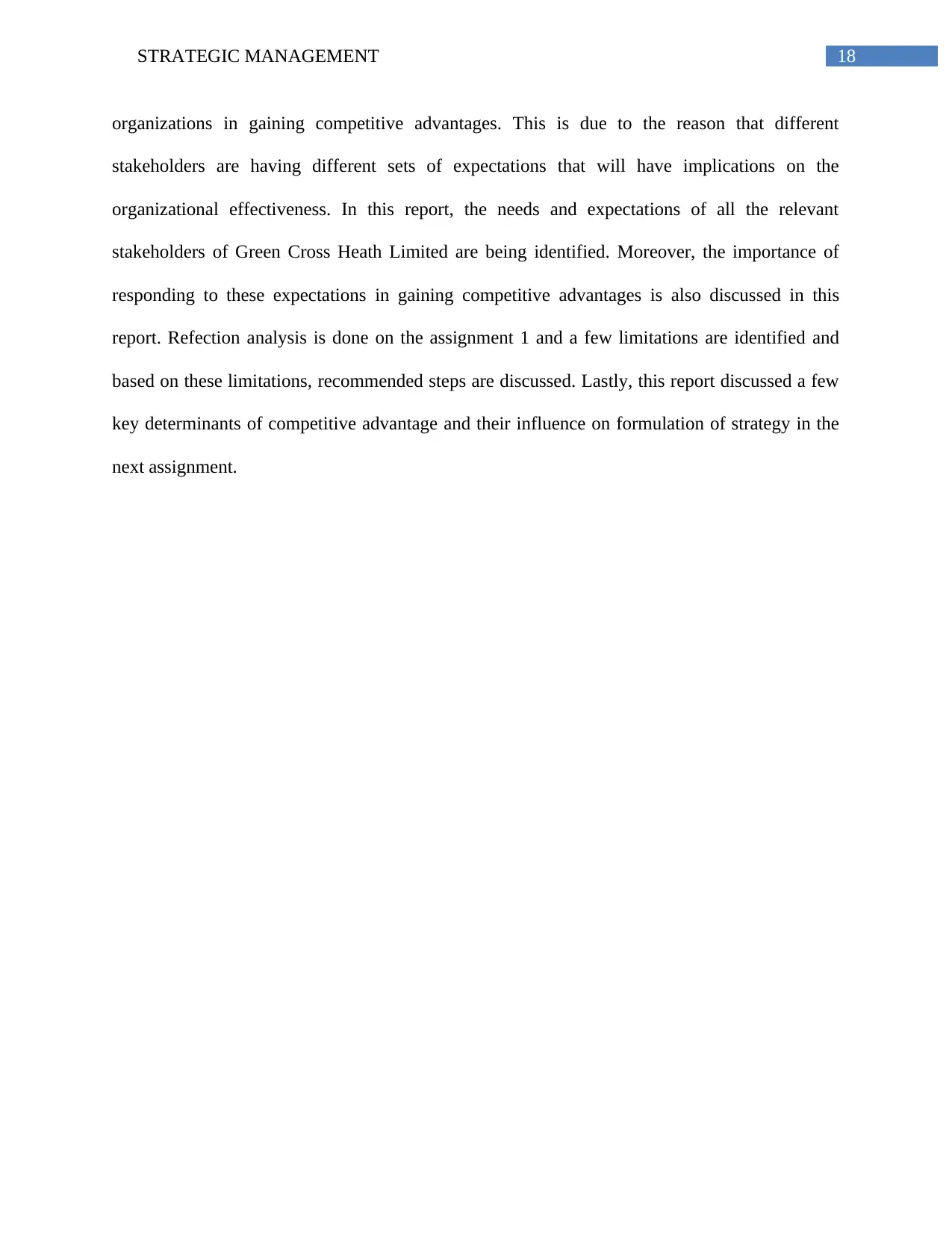
18STRATEGIC MANAGEMENT
organizations in gaining competitive advantages. This is due to the reason that different
stakeholders are having different sets of expectations that will have implications on the
organizational effectiveness. In this report, the needs and expectations of all the relevant
stakeholders of Green Cross Heath Limited are being identified. Moreover, the importance of
responding to these expectations in gaining competitive advantages is also discussed in this
report. Refection analysis is done on the assignment 1 and a few limitations are identified and
based on these limitations, recommended steps are discussed. Lastly, this report discussed a few
key determinants of competitive advantage and their influence on formulation of strategy in the
next assignment.
organizations in gaining competitive advantages. This is due to the reason that different
stakeholders are having different sets of expectations that will have implications on the
organizational effectiveness. In this report, the needs and expectations of all the relevant
stakeholders of Green Cross Heath Limited are being identified. Moreover, the importance of
responding to these expectations in gaining competitive advantages is also discussed in this
report. Refection analysis is done on the assignment 1 and a few limitations are identified and
based on these limitations, recommended steps are discussed. Lastly, this report discussed a few
key determinants of competitive advantage and their influence on formulation of strategy in the
next assignment.
Paraphrase This Document
Need a fresh take? Get an instant paraphrase of this document with our AI Paraphraser
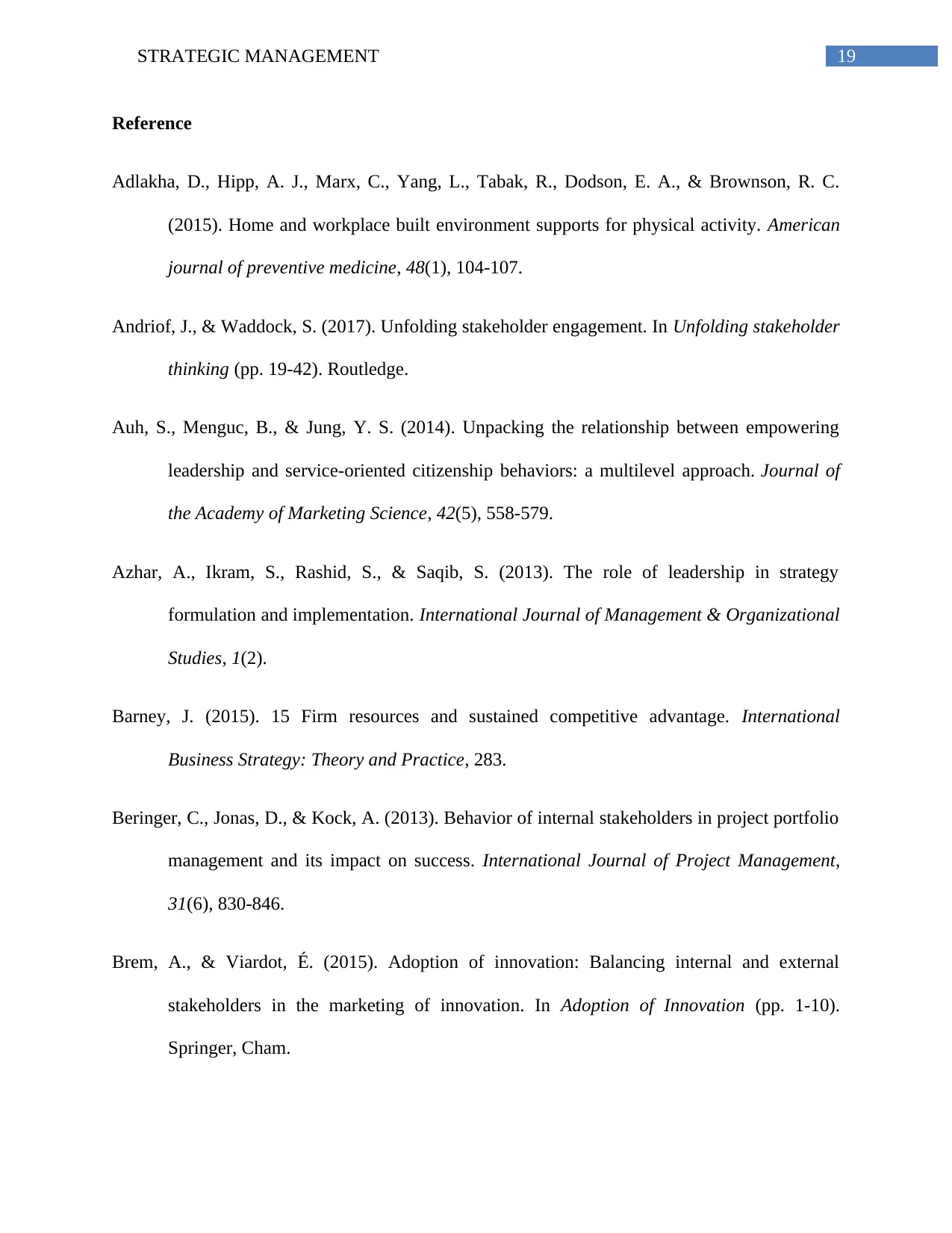
19STRATEGIC MANAGEMENT
Reference
Adlakha, D., Hipp, A. J., Marx, C., Yang, L., Tabak, R., Dodson, E. A., & Brownson, R. C.
(2015). Home and workplace built environment supports for physical activity. American
journal of preventive medicine, 48(1), 104-107.
Andriof, J., & Waddock, S. (2017). Unfolding stakeholder engagement. In Unfolding stakeholder
thinking (pp. 19-42). Routledge.
Auh, S., Menguc, B., & Jung, Y. S. (2014). Unpacking the relationship between empowering
leadership and service-oriented citizenship behaviors: a multilevel approach. Journal of
the Academy of Marketing Science, 42(5), 558-579.
Azhar, A., Ikram, S., Rashid, S., & Saqib, S. (2013). The role of leadership in strategy
formulation and implementation. International Journal of Management & Organizational
Studies, 1(2).
Barney, J. (2015). 15 Firm resources and sustained competitive advantage. International
Business Strategy: Theory and Practice, 283.
Beringer, C., Jonas, D., & Kock, A. (2013). Behavior of internal stakeholders in project portfolio
management and its impact on success. International Journal of Project Management,
31(6), 830-846.
Brem, A., & Viardot, É. (2015). Adoption of innovation: Balancing internal and external
stakeholders in the marketing of innovation. In Adoption of Innovation (pp. 1-10).
Springer, Cham.
Reference
Adlakha, D., Hipp, A. J., Marx, C., Yang, L., Tabak, R., Dodson, E. A., & Brownson, R. C.
(2015). Home and workplace built environment supports for physical activity. American
journal of preventive medicine, 48(1), 104-107.
Andriof, J., & Waddock, S. (2017). Unfolding stakeholder engagement. In Unfolding stakeholder
thinking (pp. 19-42). Routledge.
Auh, S., Menguc, B., & Jung, Y. S. (2014). Unpacking the relationship between empowering
leadership and service-oriented citizenship behaviors: a multilevel approach. Journal of
the Academy of Marketing Science, 42(5), 558-579.
Azhar, A., Ikram, S., Rashid, S., & Saqib, S. (2013). The role of leadership in strategy
formulation and implementation. International Journal of Management & Organizational
Studies, 1(2).
Barney, J. (2015). 15 Firm resources and sustained competitive advantage. International
Business Strategy: Theory and Practice, 283.
Beringer, C., Jonas, D., & Kock, A. (2013). Behavior of internal stakeholders in project portfolio
management and its impact on success. International Journal of Project Management,
31(6), 830-846.
Brem, A., & Viardot, É. (2015). Adoption of innovation: Balancing internal and external
stakeholders in the marketing of innovation. In Adoption of Innovation (pp. 1-10).
Springer, Cham.
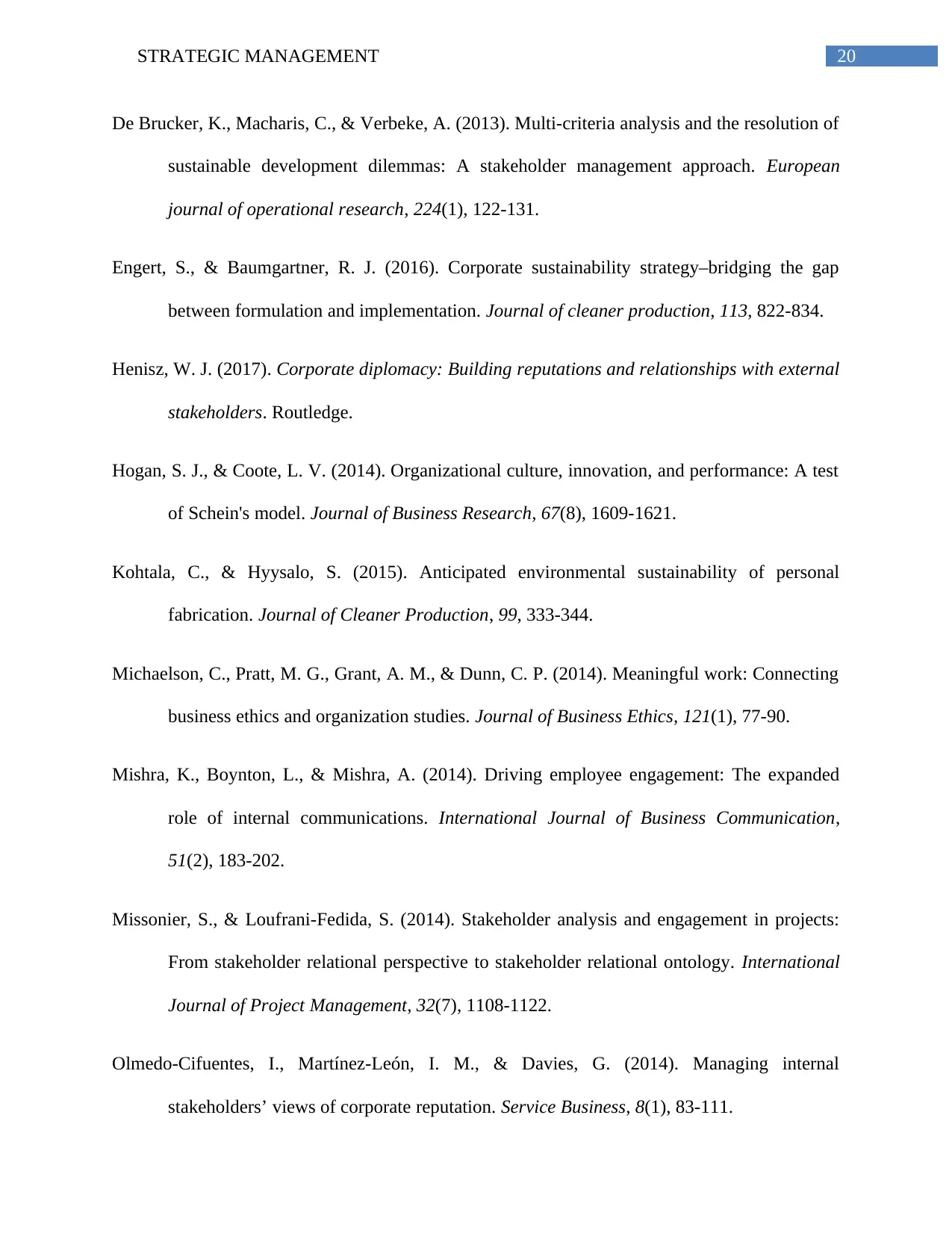
20STRATEGIC MANAGEMENT
De Brucker, K., Macharis, C., & Verbeke, A. (2013). Multi-criteria analysis and the resolution of
sustainable development dilemmas: A stakeholder management approach. European
journal of operational research, 224(1), 122-131.
Engert, S., & Baumgartner, R. J. (2016). Corporate sustainability strategy–bridging the gap
between formulation and implementation. Journal of cleaner production, 113, 822-834.
Henisz, W. J. (2017). Corporate diplomacy: Building reputations and relationships with external
stakeholders. Routledge.
Hogan, S. J., & Coote, L. V. (2014). Organizational culture, innovation, and performance: A test
of Schein's model. Journal of Business Research, 67(8), 1609-1621.
Kohtala, C., & Hyysalo, S. (2015). Anticipated environmental sustainability of personal
fabrication. Journal of Cleaner Production, 99, 333-344.
Michaelson, C., Pratt, M. G., Grant, A. M., & Dunn, C. P. (2014). Meaningful work: Connecting
business ethics and organization studies. Journal of Business Ethics, 121(1), 77-90.
Mishra, K., Boynton, L., & Mishra, A. (2014). Driving employee engagement: The expanded
role of internal communications. International Journal of Business Communication,
51(2), 183-202.
Missonier, S., & Loufrani-Fedida, S. (2014). Stakeholder analysis and engagement in projects:
From stakeholder relational perspective to stakeholder relational ontology. International
Journal of Project Management, 32(7), 1108-1122.
Olmedo-Cifuentes, I., Martínez-León, I. M., & Davies, G. (2014). Managing internal
stakeholders’ views of corporate reputation. Service Business, 8(1), 83-111.
De Brucker, K., Macharis, C., & Verbeke, A. (2013). Multi-criteria analysis and the resolution of
sustainable development dilemmas: A stakeholder management approach. European
journal of operational research, 224(1), 122-131.
Engert, S., & Baumgartner, R. J. (2016). Corporate sustainability strategy–bridging the gap
between formulation and implementation. Journal of cleaner production, 113, 822-834.
Henisz, W. J. (2017). Corporate diplomacy: Building reputations and relationships with external
stakeholders. Routledge.
Hogan, S. J., & Coote, L. V. (2014). Organizational culture, innovation, and performance: A test
of Schein's model. Journal of Business Research, 67(8), 1609-1621.
Kohtala, C., & Hyysalo, S. (2015). Anticipated environmental sustainability of personal
fabrication. Journal of Cleaner Production, 99, 333-344.
Michaelson, C., Pratt, M. G., Grant, A. M., & Dunn, C. P. (2014). Meaningful work: Connecting
business ethics and organization studies. Journal of Business Ethics, 121(1), 77-90.
Mishra, K., Boynton, L., & Mishra, A. (2014). Driving employee engagement: The expanded
role of internal communications. International Journal of Business Communication,
51(2), 183-202.
Missonier, S., & Loufrani-Fedida, S. (2014). Stakeholder analysis and engagement in projects:
From stakeholder relational perspective to stakeholder relational ontology. International
Journal of Project Management, 32(7), 1108-1122.
Olmedo-Cifuentes, I., Martínez-León, I. M., & Davies, G. (2014). Managing internal
stakeholders’ views of corporate reputation. Service Business, 8(1), 83-111.
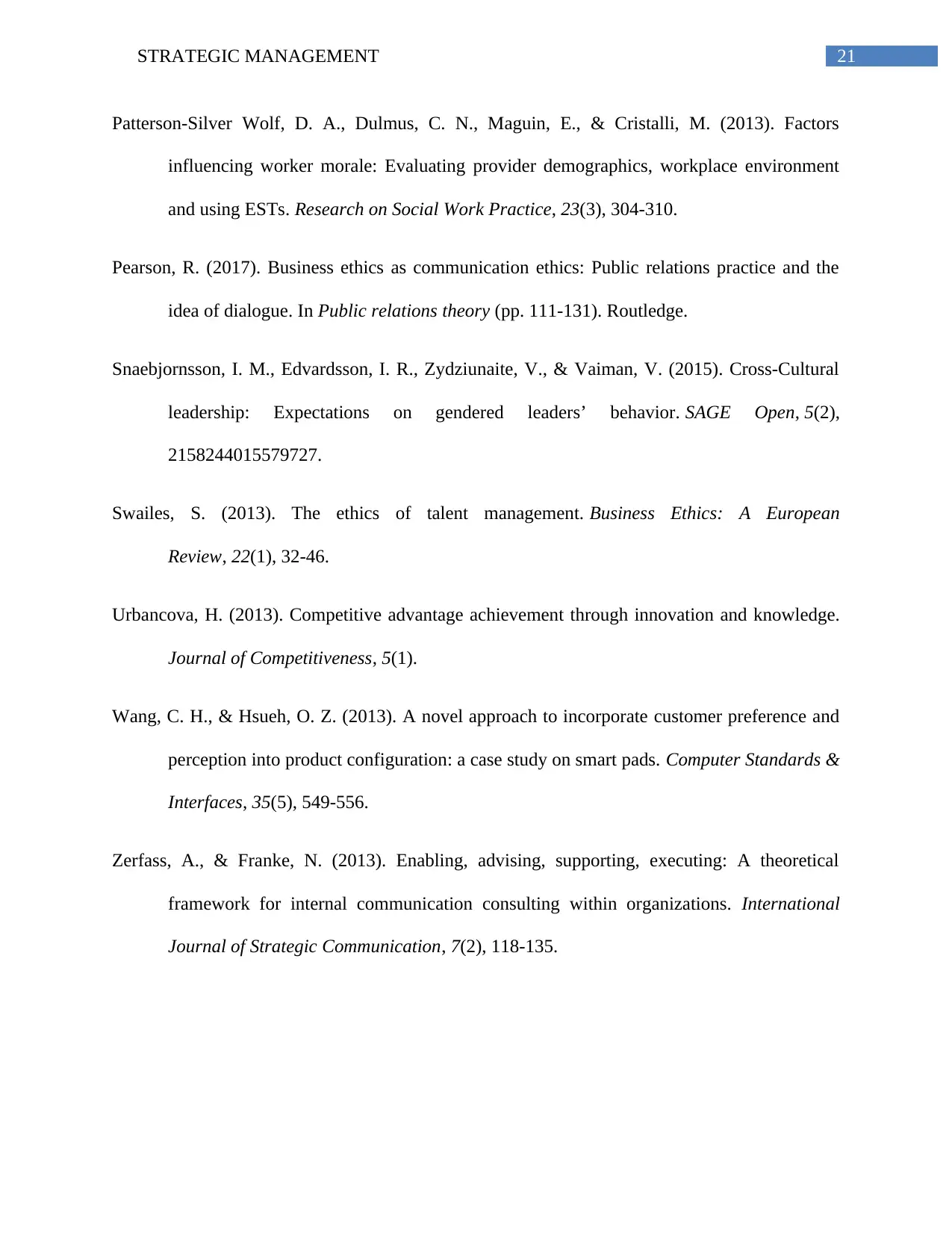
21STRATEGIC MANAGEMENT
Patterson-Silver Wolf, D. A., Dulmus, C. N., Maguin, E., & Cristalli, M. (2013). Factors
influencing worker morale: Evaluating provider demographics, workplace environment
and using ESTs. Research on Social Work Practice, 23(3), 304-310.
Pearson, R. (2017). Business ethics as communication ethics: Public relations practice and the
idea of dialogue. In Public relations theory (pp. 111-131). Routledge.
Snaebjornsson, I. M., Edvardsson, I. R., Zydziunaite, V., & Vaiman, V. (2015). Cross-Cultural
leadership: Expectations on gendered leaders’ behavior. SAGE Open, 5(2),
2158244015579727.
Swailes, S. (2013). The ethics of talent management. Business Ethics: A European
Review, 22(1), 32-46.
Urbancova, H. (2013). Competitive advantage achievement through innovation and knowledge.
Journal of Competitiveness, 5(1).
Wang, C. H., & Hsueh, O. Z. (2013). A novel approach to incorporate customer preference and
perception into product configuration: a case study on smart pads. Computer Standards &
Interfaces, 35(5), 549-556.
Zerfass, A., & Franke, N. (2013). Enabling, advising, supporting, executing: A theoretical
framework for internal communication consulting within organizations. International
Journal of Strategic Communication, 7(2), 118-135.
Patterson-Silver Wolf, D. A., Dulmus, C. N., Maguin, E., & Cristalli, M. (2013). Factors
influencing worker morale: Evaluating provider demographics, workplace environment
and using ESTs. Research on Social Work Practice, 23(3), 304-310.
Pearson, R. (2017). Business ethics as communication ethics: Public relations practice and the
idea of dialogue. In Public relations theory (pp. 111-131). Routledge.
Snaebjornsson, I. M., Edvardsson, I. R., Zydziunaite, V., & Vaiman, V. (2015). Cross-Cultural
leadership: Expectations on gendered leaders’ behavior. SAGE Open, 5(2),
2158244015579727.
Swailes, S. (2013). The ethics of talent management. Business Ethics: A European
Review, 22(1), 32-46.
Urbancova, H. (2013). Competitive advantage achievement through innovation and knowledge.
Journal of Competitiveness, 5(1).
Wang, C. H., & Hsueh, O. Z. (2013). A novel approach to incorporate customer preference and
perception into product configuration: a case study on smart pads. Computer Standards &
Interfaces, 35(5), 549-556.
Zerfass, A., & Franke, N. (2013). Enabling, advising, supporting, executing: A theoretical
framework for internal communication consulting within organizations. International
Journal of Strategic Communication, 7(2), 118-135.
1 out of 22
Related Documents
Your All-in-One AI-Powered Toolkit for Academic Success.
+13062052269
info@desklib.com
Available 24*7 on WhatsApp / Email
![[object Object]](/_next/static/media/star-bottom.7253800d.svg)
Unlock your academic potential
© 2024 | Zucol Services PVT LTD | All rights reserved.




